Political Science department organizes
On Friday, Nov. 22, Vassar’s Political Science Department hosted the Conference on Decoding the Election (CODE), a full-day event that included professors from Vassar and other nearby colleges, local politicians, judges and lawyers. The event held panels on the three branches of government — executive, legislative and judicial — the future of democracy and Americans’ political behavior in the 2024 election.
CODE was organized by Political Science Research Assistant Michelle Itkin ’26 and Associate Professor of Political Science Taneisha Means. Itkin originally approached Means in November 2023 with the idea for a much smaller event of a few panels; Means then suggested an expansive, fullday conference. CODE took on new urgency following former President Donald Trump’s victory in the 2024 presidential election. Itkin noted, “It really ramped up in planning over the last two weeks, just because we had to pivot so much since the election actually happened, since this was not the outcome we were expecting.”
Itkin explained the reasons for holding the conference: “Vassar students are very intellectually curious about things like this, no matter what their actual major is. So I figured people would want a space to study and analyze and reflect on that out-
Vassar College’s
1866
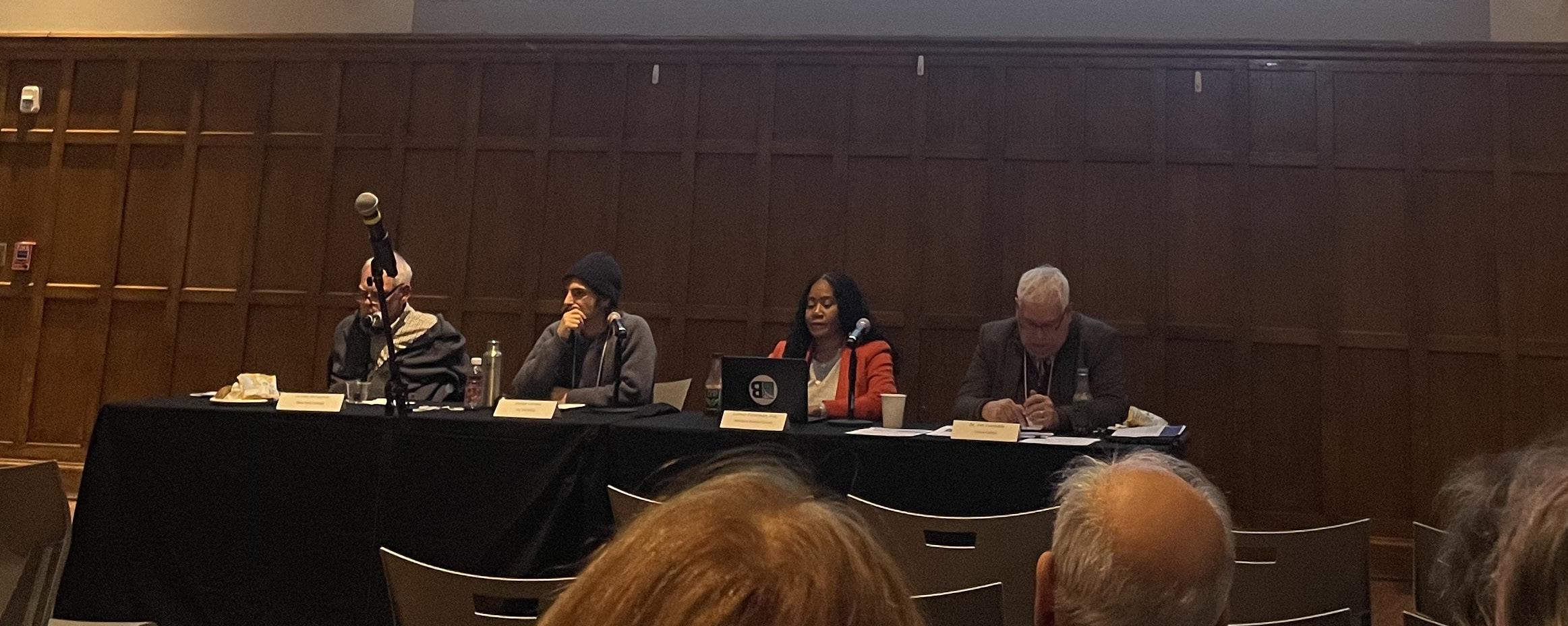
side of just the typical classroom setting.” Adam Murphy ’10, a civil rights lawyer who presented on CODE’s Judicial Branch panel, told The Miscellany News by email, “You have to understand an issue before identifying potential solutions. My hope, then, is that the event helps us identify the unique challenges ahead so that we can begin to brainstorm solutions that are tailored to those challenges.”
Throughout CODE, panelists focused time and again on the importance of local politics, especially in light of Republicans controlling all branches of the federal government starting in January 2025. In the Executive Branch panel, Professor of His-
tory Rebecca Edwards, currently on leave from Vassar while serving as the Poughkeepsie Town Supervisor, put it clearly:
“We ignore the local at our peril.” She argued that focus on federal elections and a lack of local news sources leads to low voter turnout in local elections. Local politics, she emphasized, control an array of things that affect citizens’ day-to-day lives, from sewage to climate change.
Alfonso Lopez ’92, a seven-term member of the Virginia House of Delegates and the first Latino Democrat elected to the Virginia General Assembly, especially argued for centering local politics. In the Legislative Branch panel, Lopez contrasted the con-
tinued successes of Democrats like Virginia Senators Tim Kaine and Mark Warner with Vice President Kamala Harris’ failure to attract working-class minorities. “It’s about local politics, local issues,” Lopez said of Harris’ loss of Black and Latino voters compared to President Joe Biden’s performance in the 2020 election.
Lopez also asserted that Republicans’ strong hold on the federal government for at least the next two years — until the 2026 midterms — will require citizens to shift their attention to local elections and political activism. In an interview with The Miscellany News after the conference, Lo-
Peggy Ahwesh visits Vassar Women’s XC make history
On Wednesday, Nov. 20, the Film and Women, Feminist, and Queer Studies Departments hosted feminist experimental filmmaker Peggy Ahwesh for a screening and Q&A session. According to the Brooklyn Museum, Ahwesh has produced one of the most heterogeneous bodies of work in experimental filmmaking, working across formats including Super-8, digital animation and found footage. Associate Professor and Chair of the Film Department Erica Stein introduced the filmmaker by saying, “If one thing characterizes Peggy’s dazzling films from the ’70s to today, it’s that they can’t be pinned down in terms of material, approach, aesthetic or anything else…She stretches and reimagines cinema, pushing against cliches of desire, nature and domesticity.”
The Nov. 20 event screened five films: “Kansas Atlas” (2019), “The Scary Movie” (1993), “She Puppet” (2001), “The Color of Love” (1994) and “Curve the Night Sky” (2021). These works, spanning multiple decades, serve to show the breadth of Ahwesh’s career. They vary greatly in terms of method and theme, though they each speak to many of the central questions that Ahwesh has sought to explore through her practice. “I make things for the current discourses in
Ben Richardson recaps a senior seminar class trip to the Broadway revival of 'Sunset Boulevard.'
art and philosophy, feminist theory. I mean, this is the stuff I pay a lot of attention to— and I’m not making something for a general audience, no way,” Ahwesh said.
“Kansas Atlas,” the first film shown, features aerial footage of the Kansas landscape as a voiceover poses questions about national identity, oppressive ideologies and the internal landscapes of our minds. “I’m flying over Lebanon, Kansas, the geographical center of the United States, a spot determined by balancing a cardboard cutout in the shape of our country on the head of a pin,” the film explains. “Kansas Atlas” questions the function of borders and condemns humanity’s degradation of natural landscapes.
“The Scary Movie” was screened next. “I remember the episode fondly. I was babysitting those two young women, and we made a movie together,” Ahwesh said of the film, in which the young actresses reenact classic horror movie tropes accompanied by an asynchronous soundtrack of stereotypical screams and sound effects. Ahwesh challenges typical narrative structure, as the film is composed of three unedited rolls of Super-8 footage spliced together. The notion of play is similarly complicated, as viewers watch the two young girls investigate gender roles and power structures. For the Film-Makers’ Cooperative, Patrick Fiel of

Makingtheir return to the big dance, the Vassar women’s cross country team raced at the NCAA Division III Cross Country National Championships for their second consecutive year. On Saturday, Nov. 23 in Terre Haute, Indiana, the team ran with the best cross-country teams in the nation. The Brewers placed 20th, beating their regional rivals Middlebury College, Wesleyan University and Connecticut College.
Throughout the fall, Head Coach James McCowan stressed that the road to nationals would not match the route taken last year. Coming up short in the results at big out-of-region competitions like the Paul Short Run and Connecticut College Invitational presented the team with some adversity. However, once the women entered the postseason, they made a quick turn in the right direction.
The team reminded everyone that they were fast, connected and skilled competitors at the Liberty League Championships, where they were crowned back-to-back champions. Led by first-place finisher sophomore Haley Schoenegge, the Brewers ran a strategic race, running away from rival Rensselaer Polytechnic Institute (RPI) with both team and individual titles. Vassar’s top seven finishers Schoenegge, Addie Ny-
Vassar Alliance for Ukraine commemorated a decade of war with an educational panel: read more.
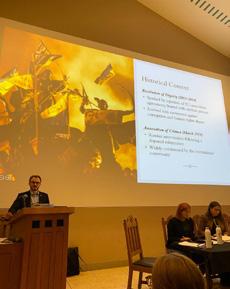
han ’27, Anna Kaigle ’25, Norah Reade ’27, Cayley Swaim ’27, Noni Pattington ’25 and Ace Helfand ’27 all earned All-League selections. Nyhan shared, “We didn’t come in as the favorites which was different from last year. We were predicted to get third and RPI is a really strong team so beating them was a great confidence booster to go into regionals and have a really great race.”
Two weeks later, the Brewers posted a perfect score at the Eastern Collegiate Athletic Conference championships. The first through seventh place Vassar sweep was led by freshman Lizzie Lowe who controlled the race from the gun. This was Vassar’s last year as a member of the ECAC—it is safe to say they went out with a bang.
All eyes were on the Brewers at the Mideast Regional Championships. The winner of each regional championship receives an automatic bid to the NCAA National Championship race; however, the next few finishing teams can also receive a bid based upon performance at regionals and season history. Entering the race, the Brewers were ranked 26th in the nation and sixth in the region. It was an incredibly close race: Three points separated the second to fifthplace finishing teams. Vassar pulled an upset, defeating Middlebury when it mattered the most. The Brewers left regionals with a program best finish of fourth place, four
Nicholas Tillinghast ponders Buffalo, antique dolls and pregnant Garfield while home for Thanksgiving.


THE MISCELLANY NEWS
EDITOR-IN-CHIEF
MANAGING EDITOR SENIOR EDITORS
CONTRIBUTING EDITOR NEWS EDITORS
ARTS EDITOR
ASSISTANT ARTS EDITOR FEATURES EDITORS
ASSISTANT FEATURES EDITOR OPINIONS EDITORS
HUMOR EDITORS
ASSISTANT HUMOR EDITOR
SPORTS EDITOR
ASSISTANT SPORTS EDITOR DESIGN EDITORS
ASSISTANT DESIGN EDITORS
COPY EDITORS
ASSISTANT COPY EDITORS
GRAPHICS EDITOR GAMES EDITOR SOCIAL MEDIA MANAGERS
LIVE EVENTS CHAIR
WEBMASTER REPORTERS/COLUMNISTS
Charlotte Robertson
Maryam Bacchus
Allen Hale
Jesse Koblin
Nicolas Villamil
Jacques Abou-Rizk
Allison Lowe
Sarah McNeil
Makenna Monaghan
Emma Adams
Madeleine Nicks
Yaksha Gummadapu
Caris Lee
Luke Jenkins
Soren Fischer
Lev Winickoff
Oliver Stewart
Nicholas Tillinghast
Josie Wenner
Henry France
Casey McMenamin
Molly Delahunty
Ellie Kogan
Amelia Gracie
Lucas Seguinot
Darja Coutts
Anabel Lee
Willa Jewitt
Ailynn O’Neill
Tori Kim
Felix Mundy-Mancino
Olivia Khan
Richard Lu
Fallon Dern
Kai Chang
Jordan Alch
Julian Balsley
Emma Brown
Wren Buehler
Ben Kaplan
Anna Kozloski
CARTOONISTS
COPY STAFF
Andrew Chu
Ian Watanabe
Sadie Bakken-Durchslag
Kathryn Carvel
Grace Finke
Paige Hahn
Quinn Kou
Claire Miller
Angela Moon
Tess Novack
Edward Welch Morgan
CORRECTION POLICY
The Miscellany News will only accept corrections for any misquotes, misrepresentations or factual errors for an article within the semester it is printed.
The Miscellany News is not responsible for the views presented within its Opinions pages. Staff editorials are the only articles that reflect the opinion of a two-thirds majority of the Editorial Board.
CODE emphasizes importance of local politics
Continued from CODE on page 1
pez expanded on this point: “It’s important that Vassar students not be discouraged,” he said. “The world needs Vassar students right now. The world needs Vassar students to get involved as actors, but more importantly, to think about running for office. And so, if I can reinforce that here as a part of my message, then that’s what I want to do.”
In her opening remarks, Itkin said she hoped the event would help tell people how to move forward from the election. “I think in terms of, like, individually, ‘What do I do now?’ I do feel a little bit better with, for example, Alfonso Lopez, who was giving us good advice about, like, ‘How do we as Vassar students get involved now with local politics?,’ ‘How do we change the climate
of D.C. with phone banking?’” Itkin told The Miscellany News. “He was giving us concrete things that we actually can do to make change.” Patrick Cincotti ’28, who attended CODE, was also inspired by Lopez’s talk: “He emphasized changes at a state level and keeping it within your communities and how Vassar students are able to enact change.”
Members of the Judicial Branch panel discussed another importance of state politics. Douglas Keith, a senior counsel at the Brennan Center for Justice’s Judiciary Program, and Murphy both focused on how state courts can more expansively protect citizens’ rights than federal courts. Both referred to the common adage, “The U.S. Constitution is a floor”: States must at least guarantee the rights in the federal constitu-
tion but may give their citizens additional ones. Keith noted that since the U.S. Supreme Court is refusing to protect particular rights — such as the right to abortion or LGBTQ+ rights — they are bringing cases to state courts, where they feel they have a better chance of winning. As Murphy discussed, some of those cases involve prohibiting certain punishments. For instance, the Washington Supreme Court declared the death penalty unconstitutional in 2018 and, in 2024, the Massachusetts Supreme Judicial Court prohibited life without parole sentences for people under 21. Murphy told The Miscellany News, “I think many important legal challenges will come via state courts and state constitutions…State constitutions can and often do provide greater protections for people than the fed-
eral constitution. Lawyers and advocates who are looking to expand rights need to think hard about shifting at least some of our advocacy efforts from federal courts to state courts.”
“I think it went really well, and I was really happy with how it turned out,” Itkin said after the conference. Holding events like CODE at a college matters, she said, because whether or not young voters turn out in elections can make the difference in close races. She explained, “I think generally in American history, and today, and at Vassar, college-age students are generally thinking a lot about activism, but need to put all of that thought and care into actually turning out to vote.”
Additional reporting by Makenna Monaghan.
Comedians expose the VSA at Town Hall Roast
Sarah McNeil News Editor
The Vassar Student Association (VSA) hosted a Town Hall with a twist on Nov. 21. The event doubled as a roast of the VSA, inviting students and college comedians alike to offer constructive criticism and share a laugh. The Mug housed a full crowd of students gathered to watch several members of Indecent Exposure, a standup comedy group for women, trans, and nonbinary folks, open at the Town Hall and poke fun at some campus policies.
Every semester, the VSA hosts a minimum of one Town Hall for students to meet members of the VSA, ask questions and provide feedback on what issues matter most to them. The Town Halls often include collaborations and performances from various campus organizations; this Town Hall marked the first ever roast of the VSA. The VSA Director of Communications Hayden Ehrenfeld ’25 shared in a written statement to The Miscellany News, “In the past, these Town Halls have usually included a fun performance to draw students in, but this semester we wanted to do something different.” He continued, “We heard a lot of frustration about how the VSA VWash fund was insufficient to cover the rising cost of laundry, so we thought: why not tackle that head-on? That’s where the idea for the ‘roast’ came from. We wanted to combine comedy with real, meaningful conversation — an event where students could voice concerns, share feedback and maybe even laugh a little.”
The event’s theme, “Airing Out the Dirty Laundry,” reflected the VSA’s recent work to obtain free laundry for the student body. Currently, all Vassar students on financial aid receive a $32.50 stipend towards laundry. This semester, the VSA voted to increase the stipend from $32.50 to $46.80, which will go into effect at the start of the Spring ’25 semester. The VSA does not plan to stop there; Ehrenfeld commented: “One of our biggest goals is to get free laundry, which honestly isn’t a stretch. So many of our peer institutions already provide it for their students. But making free laundry a reality takes more than just VSA efforts—it needs the collective support of students to fuel change.”
The event served as an opportunity for the VSA to educate and engage the student body and announce their laundry petition, a VSA initiative hoping to rally student support for free laundry. Class of 2025 Senator Charlie From confirmed in a written
correspondence with The Miscellany News that the laundry petition will be voted on at this week’s upcoming senate meeting. While the roast was centered around laundry, the event covered a wide array of campus issues. Three members of Indecent Exposure performed: Vice President and Treasurer Dora Graham ’26, Kaila Dunn ’25 and Ellie Tinely ’27. Their remarks touched upon student frustrations from various aspects of student life. Multiple comedians critiqued the functionality of VCycle, the campus bike system that launched in the Fall of 2023 and expressed disappointment with the bike app On Bike Share. Another topic tackled by the comedians was the VSA’s allocation of funds in the wake of the widespread VSA budget cuts for campus organizations. One comedian took a jab at the event being catered by Twisted Soul in response. Graham mentioned these issues came up when discussing what concerns were most important to students, “We started with an open document, and what would be funny and some of the things that came to mind were things that annoyed us like VCycle, apparently VCycle comes up a lot in our group.” They added, “I announced in my random class that I’m TA’ing, ‘What should I make fun of the VSA for?’ and they said they ‘The f— budget cuts!’ And I was like you’re right!”
The comedians also broached the topic of the Saturday Shuttle, a program overseen by the VSA that provides weekly transportation around Poughkeepsie to different shopping locations and the train station. The program was critiqued by one comedian for its confusing schedule.
These critiques were appreciated by the VSA. Ehrenfeld wrote, “We also wanted to own up to some mistakes we’ve made this semester. For example, the roll-out of the Saturday Shuttle schedule wasn’t as clear as it should have been. We acknowledged that by taking some playful heat from Indecent Exposure and showing students that we’re committed to doing better. Our Director of Services, Olivia Del Tatto ’27, who oversees programs like the Saturday Shuttle and VCycle, shared updates about the NYC shuttle we’re sponsoring.”
Following Indecent Exposure’s set, the crowd noticeably dwindled. VSA President Emily Doucet ’25 took to the stage to thank Indecent and offer her own remarks before turning it over to several members of the VSA. Four Executive Board members — Director of Services Olivia De Tatto ’27, Director of Student Events Faye Stevens ’25, Director of Student Organizations Mariano
De Cavalho ’25 and Director of Wellness Sofia Balich ’25 — discussed their roles within the VSA and addressed several issues raised during the roast. VSA members had to opt into being mentioned by name, with only one VSA member — De Cavalho — having consented to be a subject of the roast.
After hearing from several VSA Executive Board members, Indecent Exposure performed a humorous sketch depicting a VSA meeting. In closing, the VSA opened the floor to questions from students; the audience did not participate.
One student in attendance, Julia Rossi ’27, came to the event to watch a friend perform in Indecent Exposure. Of the VSA initiatives, Rossi said, “I didn’t really go in here thinking much about them, but I was interested in what they were saying about laundry. Yeah, I was kind of surprised to hear that they’ve made so much progress towards free laundry and I hadn’t realized that it was such the norm with other col-
leges to have free laundry, so I was excited to hear about the possibility of that.” They continued, “I think it made me appreciate that the VSA was willing to put this on and that they appreciate comedy and different student orgs like that.”
Tinley shared after her set, “I think the event went really well. It was a really good environment in the room, lots of laughs and lots of silliness, but also the VSA got a chance to talk to some of the students which was really good and we got to talk about our wonderful org as well.”
The roast aimed to engage with the student body and provide a space to laugh and learn in tandem and open a line of dialogue with the campus community. Ehrenheld commented, “We hope this mix of humor and open dialogue helps students feel heard while also keeping things fun. Criticism doesn’t have to be all serious—it can be a catalyst for change. And the VSA is here for that.”

Breaking down the snubs and shocks of Grammy nominations
Brendan Kennedy Guest Columnist
On a brisk afternoon in mid-November, I found myself in The Bridge with a group of friends discussing the captivating topic of Taylor Swift over iced lattes. Some of us argued her new album, “The Tortured Poets Department,” was uncreative and lackluster in the grand scheme of the year. “How could an album as sonically boring as ‘The Tortured Poets Department’ stack up to the year’s megahits like ‘Brat’, by Charli XCX and ‘Cowboy Carter,’ by Beyoncé?” we contended. Luckily, we remembered there is a basis of calibration in the discussion of albums in context of the year they were created: the Grammys. The conversation slowly turned into an all-out brawl as we pulled out the nomination list for the 67th Annual Grammy Awards and debated the Big Four categories: Album of the Year, Song of the Year, Record of the Year and Best New Artist.
In a storm of excitement and disappointment, I started to notice many patterns with the nominations. For far too long, the Grammys have stuck to their own agenda: nominating pop-heavy albums made by superstars. I seek issue with this because lesser-known artists, who are equally as good as the top contenders, are often excluded from the awards. Thus, looking at the nominations for 2024 specifically allows us to divulge into the world of snubs, shocks and stolen spotlight in association with the Grammys.
Beyoncé, the musical powerhouse that she is, leads the pack of nominations with 11; this is not a surprise considering the revolutionary essence of “Cowboy Carter.” Captivatingly, Beyoncé attempted something new with this album, fighting the standards of musical genres and embracing a new concept of cohesion. On “Cowboy Carter,” she incorporates country, rock, pop, folk and even hip-hop into a singular album. On Track 12, “SPAGHETTII,” she explains, “Genres are a funny little concept, aren’t they? Yes, they are.”
In a shocking turn of events, André 3000’s lyric-less, ambient debut album, “New Blue Sun,” secured a nomination. While I have not listened yet, Pitchfork—a
publication which often releases controversial music reviews—acclaimed the album, giving it a rare 8.3/10 while describing the work as beautiful, demanding and fascinating. This is a captivating nomination, as the album has zero vocals, making it a standout selection from its counterparts. Similarly, Charli XCX received her first nomination in 10 years for her critically acclaimed album “Brat.” This is particularly exciting because, despite being an immensely creative artist, Charli is often overlooked when it comes to awards.
Breakout stars of the year Chappell Roan and Sabrina Carpenter both secured nominations for their respective 2024 albums, “The Rise and Fall of a Midwest Princess” and “Short n’ Sweet.” Both have had an immensely successful year, crashing chart records and captivating audiences daily; thus, their nominations do not come as a surprise. I believe audiences are drawn to them due to the uniqueness they bring to the industry. Carpenter, with songs like “Espresso” and “Please Please Please,” enhances the listeners with quippy and quirky lyricism. You never quite know what she is going to discuss in her songs, bringing a new “cheekiness” to the medium. Roan, while also using stark lyricism, creates an entirely new sound for popular music. Songs like “Red Wine Supernova” and “HOT TO GO!” break the standards of “basic pop” and instead incorporate witty language with a more theatrical tone. Furthermore, her incorporation of queer experience within her music acts as an outlet for much of the younger generation to listen and relate to. Personally, I am excited to see where they decide to take their respective careers in the next few years, as they are certainly destined for greatness in the music scene.
The biggest snub of the year easily goes to Ariana Grande. Grande’s new album, “eternal sunshine,” charmed listeners across the board, even achieving two No. 1 singles with “yes, and?” and “we can’t be friends (wait for your love).” However, Grande was not nominated in any of the Big Four categories, most notably Album of the Year. This is out of the ordinary for Grande, as she once won the category for her 2019 album “thank u, next.” Many thought “eter-
nal sunshine” would be a shoe-in for this year’s nominations, but the outcome is simply not the case. One answer for this could be due to Grande’s lack of promotion and involvement in the project as a whole. She has spent the majority of the year promoting the new movie-musical adaptation “Wicked,” in which she starred, instead of focusing on her music career. Therefore, the Grammys noticed her lack of enthusiasm with the project and did not award it accordingly.
Finally, Taylor Swift received six nominations for her 11th studio album. I would consider myself a fan of Swift, even attending the Eras Tour back in 2023. Yet, I do not believe her new album is as worthy as the nominations seem to suggest. It simply does not stack up against her previous award-winning works—like “folklore” and “1989”—neither creatively nor compellingly. Swift adhered to her basic synth-pop sound for “The Tortured Poets Department” and worked with the same producers as her
previous records, Jack Antonoff and Aaron Dessner. Many fans complained that Swift did not break out of her comfort zone and kept the same sound as her previous record “Midnights.” Still, Swift will continue to earn nominations, no matter how lackluster her album may be, because she is what draws in audiences to the ceremony. Without Swift in attendance, viewership will drastically decrease simply due to her tremendous popularity. Consequently, Swift may never lean away from her current genre and sound, simply due to her comfortability.
While I have not commented on all the nominations, these surprises and oversights play a prominent role in this year’s awards. The current music industry is destined for rises and falls, and not just in the “Midwest Princess” way. The current scene is fascinating, and the ceremony is sure to be no different. The 67th Annual Grammy Awards will be a bloodbath, and I am excited to see who climbs to the throne.
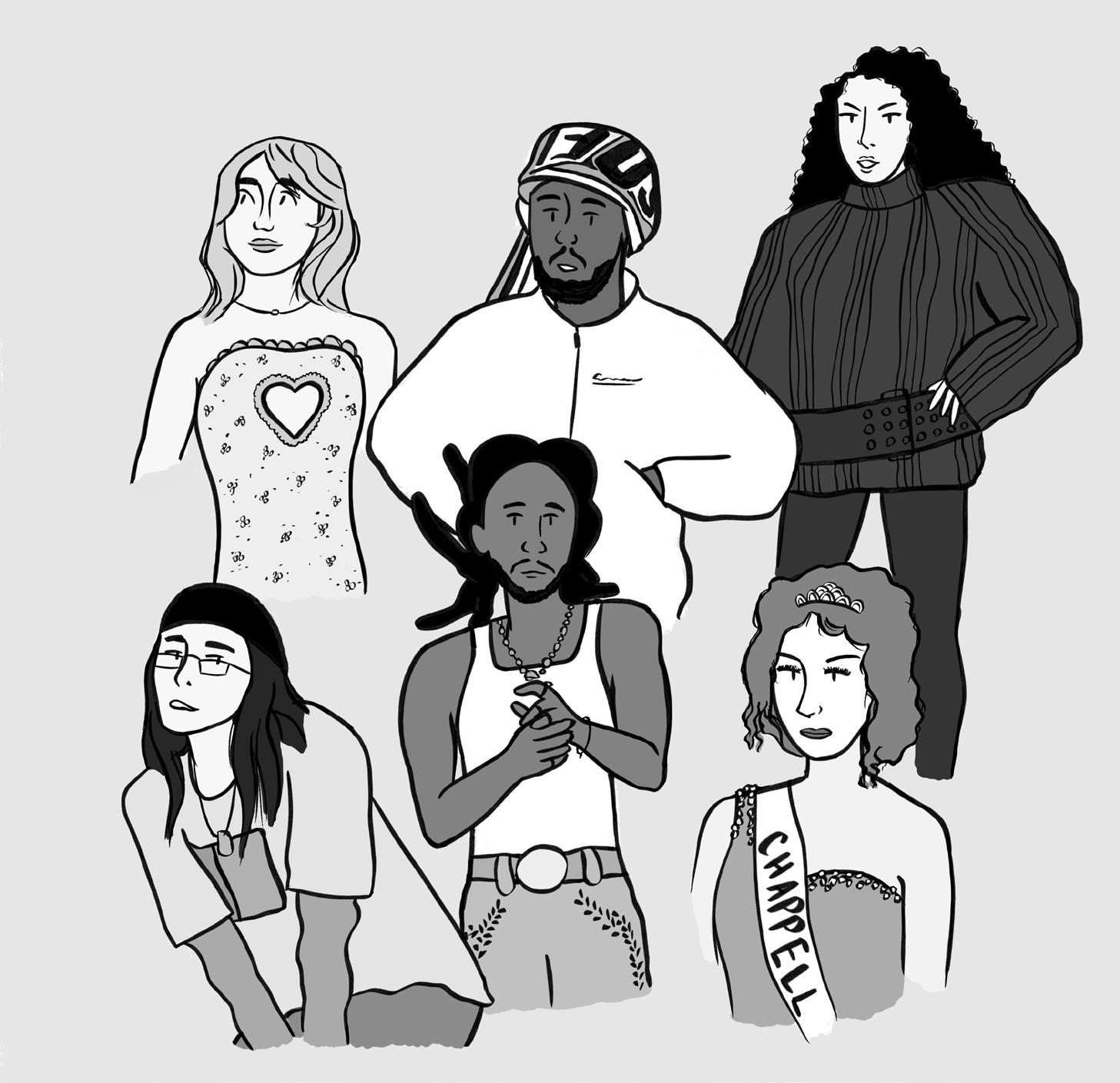
Filmmaker Ahwesh talks feminism and reappropriation
the Indianapolis Museum of Art described the nine-minute film by saying, “[It] is an amazingly complex (and just plain amazing) film informed by a wide range of issues and concerns, including feminism, psychoanalytic theory (especially Jacques Lacan), home-movie aesthetics, film genre conventions, and the notion of self-reflexivity in film.”
In this same vein, Ahwesh’s work often seeks to reimagine scenarios from a feminist perspective. “She Puppet,” for instance, is composed of footage Ahwesh collected while playing the video game “Tomb Raider.” Ahwesh then treated the videos of herself playing the game as found footage, reappropriating them in order to question ideas of mortality and the symbolic feminine. “The Color of Love” similarly reappropriates found footage. “Someone brought a donation to the school I was teaching at [Bard College], and it was all empty cans and reels,” Ahwesh described. The only film Ahwesh was able to recover was a ’70s pornographic film that had been damaged by rain. The decay caused by the water damage
makes it so the film undulates with images and patterns frequently disappearing and reappearing. In her reimagining of this footage, Ahwesh centers the erotic exchanges between women in the film, which had previously been relegated to the margins of the frame.
The final film of the Nov. 20 screening was “Curve the Night Sky.” The film thematically bookended the event, as viewers were able to return to contemplative explorations of landscape that mirrored the spirit of “Kansas Atlas.” Ahwesh explained how this film came to be during the COVID-19 lockdown. She shot around her neighborhood at night, observing the infrastructure of her town. “It’s kind of a COVID project,” Ahwesh explained. “Everything is shot around my house.” In the film, she plays with the strangeness of light, shining a flashlight on overhead cables and purposefully triggering motion-activated lighting systems. Shot during a period in which the world was often described as being shut down, “Curve the Night Sky” finds ways to depict the fascinating parts of society that remained at work.
As the Q&A session came to a close, Ahwesh encouraged students to play with the footage available to them. “You have to love to mess around with materials and get off
the paper,” she said. “If you go out and record enough, the world becomes very interesting, and you can find things that are surprising to you.”
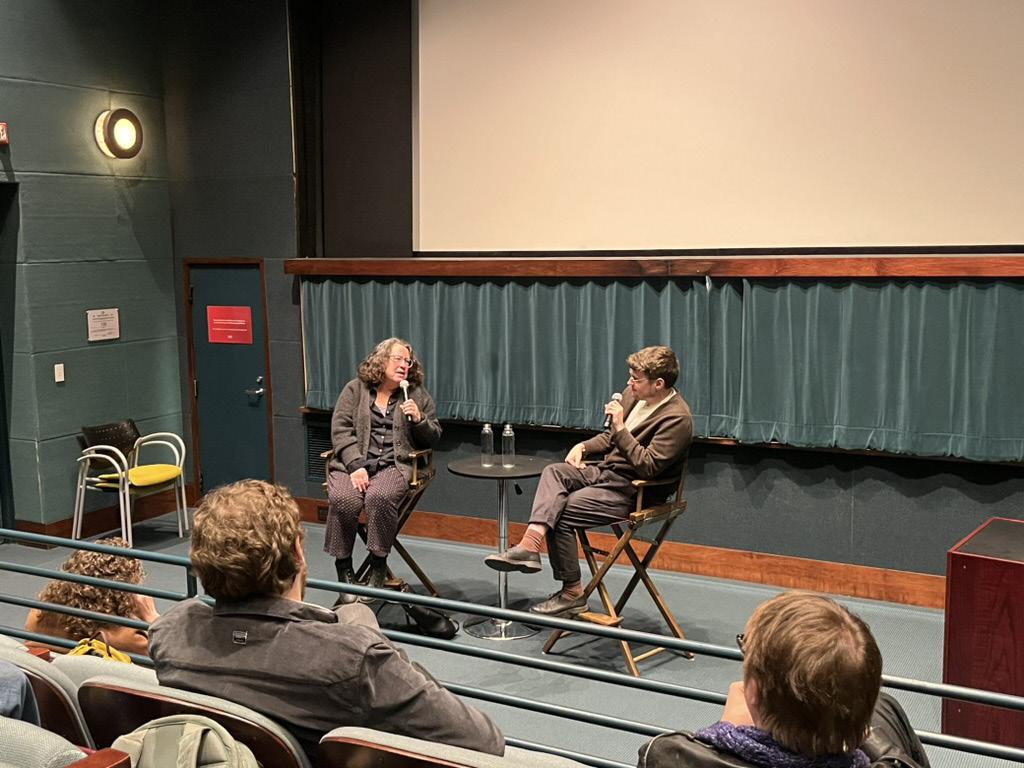
Bippity, boppity, Juul: Reviewing ‘Anora’
Eduardo Culmer Guest Columnist
Cinderella has her glass slipper, Vivian— of the 1990 film “Pretty Woman”—has her blonde bob wig, and Anora, the titular character of the newest rags-to-riches “love” story, has her Juul. Sean Baker’s film “Anora” draws on the centuries-old legends of Galatea and Cinderella, trading in the tired images of Prince Charming and his low-class damsel-in-distress for neon lights and mink fur coats; with a sharp contrast to these traditional tales, Baker eschews antiquated and romanticized tropes in favor of gritty authenticity. In the world of “Anora,” fairytale endings are replaced by a harsh yet human reality that clashes with the pastel purple and iridescent sheen of the film’s color grading. Baker uses this contrast to critique the insidious capitalist structures that push people across the world to sex work and reflect the duality of the profession’s portrayal in the media.
[SPOILERS AHEAD]
Mikey Madison plays the eponymous sex worker Anora “Ani” Mikheeva, who is employed as an exotic dancer at a strip club in Manhattan. Ani has a chance encounter with Ivan “Vanya” Zakharov, the young, wild and rich son of a Russian oligarch. After a night replete with broken Russian, lap dances and THC, Vanya asks Ani to be his “horny girlfriend” for a week (à la “Pretty Woman”), offering her $15,000 for her services. The arrangement works a little too well, with the pair getting married in an impromptu Las Vegas ceremony. Fearing his parents’ wrath over sullying the family’s name by marrying
someone deemed below his status, Vanya flees from the mansion he shares with Ani, leaving her behind in a very childish and—in Ani’s words—“unmanly manner.” After suffering bondage and assault at the hands of hired Eastern European goons working for Vanya’s father, Ani joins the men who bound and gagged her as they scramble to find her runaway groom. The plot spirals into a dark screwball comedy, with Ani eventually being forced to get her marriage to Vanya annulled in exchange for a lump sum of money from her disapproving in-laws. After a fiery departure from the marriage law office and Vanya’s family, Ani returns home with one of the aforementioned hired goons. In the last 10 minutes of the film, Baker’s auteurist signature is emphasized by an ending which, similar to his other works, kills the laughter previously filling the theater and uncomfortably brings moviegoers back to grim reality.
For the first half of the film, “Anora” is a sensuous whirlwind of vivid LED lights, flashing hair tinsel and bare flesh, drawing the audience into the age-old rags-to-riches fantasy. Similarly, Ani lounges in satin bed sheets, stuns at bacchanalian parties and jetsets with her new beau, letting herself fall into the façade alongside theatergoers. Although several Letterboxd reviewers and accredited critics have called out this portion of the film for sticking to tropes and depicting Ani as a gullible, love-sick bimbo, this reading of the narrative is reductive and incongruous with Baker’s empathetic treatment of sex workers across his filmography (e.g. “Tangerine,” “The Florida Project” and “Red Rocket”). Baker, instead, intends to use Ani as a microcosm for the larger phenomenon of “hopeless optimism,” as e-flux writer Aaron Schuester puts
it in his review of “Anora,” harking back to the Francis Bacon quote: “You can be optimistic and totally without hope.”
“Anora,” dealing with very similar themes and material, is somewhat of a spiritual foil to the 1990 film “Pretty Woman.” Vivian, the heroine of “Pretty Woman,” follows the standard Pygmalion and Galatea format. After being hired off the streets of Los Angeles by a crooked yet wealthy finance tycoon, Vivian undergoes a drastic makeover from low-brow prostitute to refined lady and is rewarded by the rich man’s hand in marriage. In this modern adaptation of the ancient story, the downon-her-luck sex worker is regarded as a product to be molded and sculpted to perfection; like Cinderella, Vivian’s internal goodness shines through her initially unkempt appearance, and she melts the cold, capital-driven heart of the Prince Charming that saves her (she drives her love interest to invest in businesses instead of speculating on their downfall). “Pretty Woman” is a fantasy film, a tour de force of the American dream. The success story Vivian lives through is more than unlikely, and she must first undergo a complete metamorphosis to be seen as valuable in the eyes of the patriarchy and of the upper class. Once Vivian’s inner goodness shines through to her exterior—and she has the support of a wealthy man at her side—she is finally ready to be accepted into polite society.
Baker’s film, on the other hand, does away with these illusions. From the moment we are introduced to the serial vaper and vapid billionaire Vanya, it is clear that he disregards Ani as a person, though he is initially kind to her. Amidst the unsatisfying (for Ani, of course) sex and silent time spent with Ani watching Vanya play video games on his
couch, the pair do not have any real or meaningful interactions. Throughout the course of the film, Vanya is further proven to be not only devoid of any feelings for Ani but morally bankrupt on the whole. Even the name he is called throughout the movie’s runtime, “Vanya,” is the childish diminutive of the name Ivan and a symbol for his immature and unempathetic view of Ani. Vanya the man-boy is constantly compared to a child and treats Ani like one of the action figures that he uses and discards in his bedroom offscreen. Once Galina and Nikolai, Vanya’s parents, are introduced, this detached inhumanity is made all the more clear. Ani is viewed first as a sexpot whose only purpose is to provide companionship and physical pleasure and second as a roadblock to be disposed of with money and brute force.
However, unlike Vivian’s class-defying transfiguration, Ani remains the same defiant woman throughout the entire film, loudly asserting herself and her right to a better future (which is, ostensibly, what Vanya and his wealth represent). Ani neither lives the class-fantasy spoon fed audiences by “Pretty Woman,” nor does she get the “eat the rich” ending that has been popularized in recent years by films such as “Triangle of Sadness” or “The Menu.” Ani’s “hopeless optimism” lies in her relentless ability to be herself despite her circumstances. Where previous films have protagonists whom audiences empathize with in spite of their position as sex workers, Baker works to destigmatize sex work itself and emphasize the personhood of those in the industry without over-glamorizing the profession itself. Baker’s Ani is not perfectly good, nor teflon strong; she is human. Consistently human.
Broadway revival of ‘Sunset Boulevard’ amazes senior class
Ben Richardson Guest Columnist
On Nov. 16, the students of Vassar Media Studies’ Senior Seminar, led by Associate Professor of Psychological Science and Director of Media Studies Dara Greenwood, headed south to Manhattan to see the Broadway revival of the Andrew Lloyd Webber Musical “Sunset Boulevard.” This specific production opened on Oct. 20 at the St. James Theater. This new production is notably directed by the acclaimed Jamie Lloyd, best known for his minimalist and expressionist retellings of classic Shakespeare plays, and stars former member of The Pussycat Dolls Nicole Scherzinger. The stage production followed the plot of the film on which it is very closely based. Set in 1949, a young, financially struggling screenwriter named Joe Gillis, played by understudy Diego Andres Rodriguez, enters a scandalous relationship with the has-been silent film star Norma Desmond, played by Scherzinger. The two work on a screenplay for Desmond’s major return to the screen; when the script is ultimately rejected and Gillis begins a relationship with a younger woman, things take a fatal turn. The story’s unique look at the industry side of Old Hollywood cinema could not have been more appropriate for a group of students who have all had to consider film history at some point in their Media Studies coursework. Although the Senior Seminar had previously screened the original 1950 film of the same name, nothing could have prepared me or my classmates for the visceral spectacle that this production delivered. The visual details were extremely minimal; the set was merely an expanse of black often
accompanied by swaths of fog and intricate lighting configurations. The costuming was also modern and minimal, with each character wearing just one or two simple outfits of white and black throughout. However, the defining physical feature of this production was the massive LCD screen that served as a backdrop during the majority of the production; technicians would stand onstage with rigged cameras that broadcasted directly to the screen, almost producing an arena concert jumbotron effect. This use of video and screens could have come off as a corny way for Broadway to incorporate modern technology into its productions, but this was not the case at all; the naked-eye view of the actors performing onstage juxtaposed against the massive, broadcasted close-up images of their performance cultivated a more detailed personal look at the characters and their emotions. With this intricately crafted staging, the audience’s sensory experience was essentially streamlined towards the raw emotion of the actors, which were expressed visually on-screen and through their vocal performances.
The use of the LCD screen was most significant during the opening of Act 2 where the first musical number was actually performed outside the theater on the street and broadcast to the screen inside. During this titular number, Gillis laments his struggles as a screenwriter and the tough realities of Hollywood while walking around the facade of the St. James Theater, 44th Street and Shubert Alley before returning to the stage for the remainder of Act 2. It was so refreshing to see a musical break down boundaries of the theater and to bring some reflexivity into the medium in this way.
Going into this performance, the only wildcard for me was the fact that Scherzinger would be playing the lead role of Desmond. Given her past performing with The Pussycat Dolls and her recent scandal over an Instagram comment about a MAGA-style baseball cap, I had no idea what to expect from her Broadway debut. However, after Scherzinger finally appeared on stage and performed her first major ballad, I was completely stunned. Her vocal abilities were astonishingly strong, emotional and rich. Her ability to captivate the entire theater’s attention with only her voice while standing in a void of black wearing only a simple slip dress was like nothing I had ever witnessed before. Scherzinger’s two ballads, “With One Look” and “As If We Never Said
Goodbye,” were the show’s clear highlights, as both were followed by applause that lasted for what seemed like several minutes. In addition to her vocal talents, Scherzinger’s fluid physicality and erratic emotions bolstered her performance even further. Although some students took issue with the production’s lack of a definitive set and its visual accuracy to the time period, the general consensus from the Media Studies Senior Seminar was very positive, especially regarding Scherzinger’s performance. Personally, I think this new production of “Sunset Boulevard” could be beautifully adapted into a fresh feature film retelling of the original 1950 version, especially since its staging has already has been choreographed around the gaze of the camera.
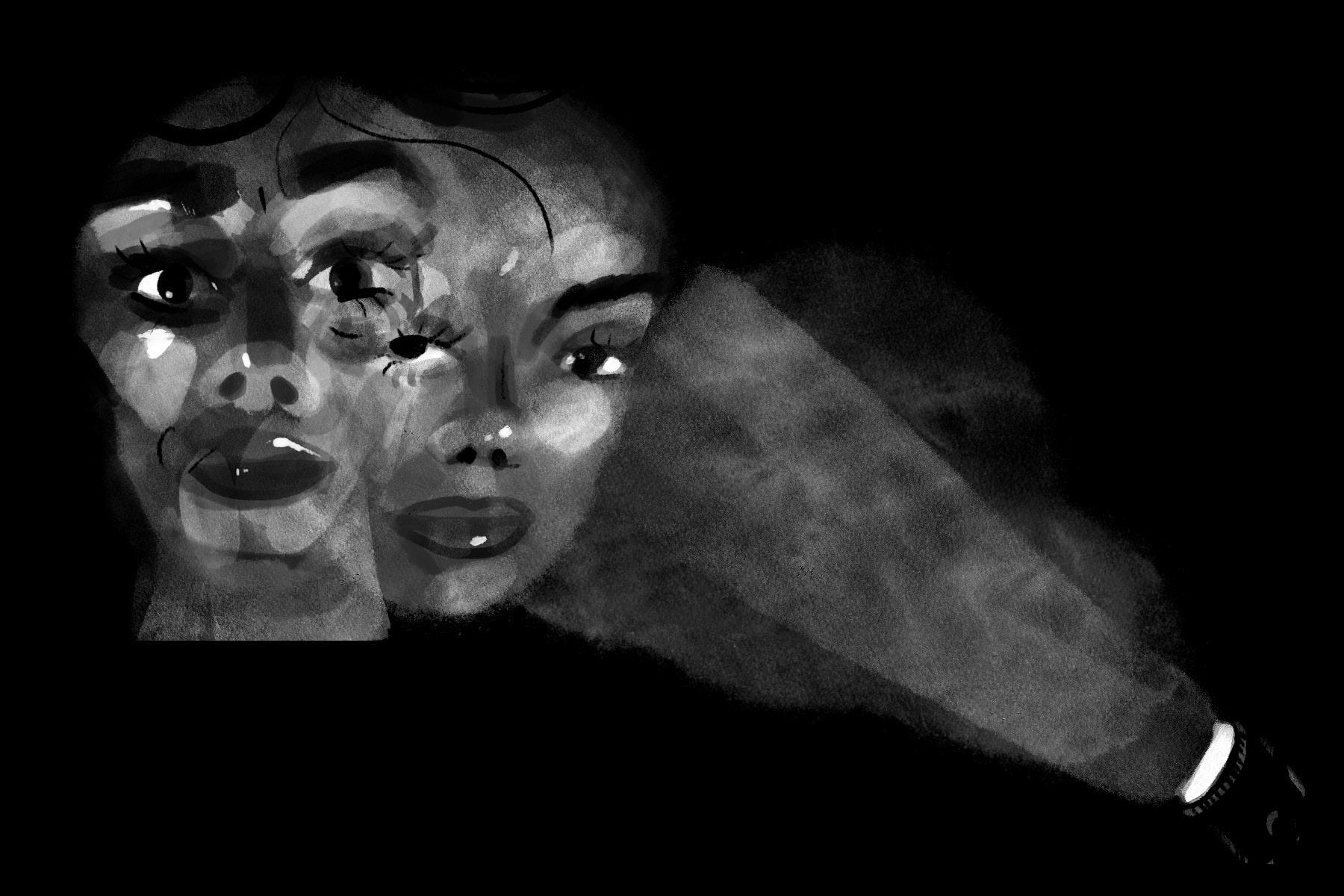
What ‘The Birdcage’ says about our culture in 2024
Benjamin Kaplan Columnist
If the last few months and weeks in America have taught us anything, it is that we are a nation obsessed with aesthetics. In the age of instant media and blink-and-youwill-miss-it culture, many people turn to something more abstract to ascertain their surroundings and the general zeitgeist around them. To put it simply, they do a vibe check. And since the election, there has been an, in my opinion, worrying trend developing: the idea that there is an objectively correct aesthetic that all Americans should strive for and let take hold of their identity. There is an understanding that the way forward is purity of soul and obedience to the religion of the American Dream as interpreted thinly by white-fence America. Think of Donald Trump Jr.’s recent Tweet that racked up 200,000 likes and engagement from Elon Musk: “Biological & objectively attractive women are allowed to win beauty pageants again. WE ARE SO BACK!!!” It is this culture war on our doorsteps that has led me to say you should take some time out of your day to watch the 1996 film “The Birdcage.”
The quirkiness central to one’s identity that sets them apart can be accepted and loved, and trying to squash it out is a fruitless effort that will only cause more problems than it solves.
At its core, “The Birdcage” is a fun ’90s adaptation of “La Cage aux Folles” starring a great cast led by Nathan Lane and Robin
Williams, wherein they play a Miamian gay couple who own a club named The Birdcage and whose son Val is bringing his fiancée’s conservative senator of a father to come and meet them. That is the surface level. It is filled with many scenes of Lane acting his heart out as the flamboyant Albert, matched perfectly by Williams as the charming and calm Armand. Gene Hackman plays a funny side role as the conservative senator Kevin Keeley, and the movie centers around how Armand and Albert have to juggle their identities to best accommodate someone who has made a successful political career out of being a proponent of traditional American values.
Much of the film focuses on Armand and Val trying to disguise Albert as a straight man. They see his expressiveness and sociality as difficult to conceal, and his identity and its connection to aesthetics is a central tenet of the plot. How does one blend into the “normal” when their identity does not fit neatly into the set paradigm of our society? An almost cartoonishly and overdone solution, which you might have seen in nearly every Disney or Pixar film of the last decade, is to just “own it.” The quirkiness central to one’s identity that sets them apart can be accepted and loved, and trying to squash it out is a fruitless effort that will only cause more problems than it solves. Assimilation is unachievable, and your aesthetic will be loved if you love yourself. But we do not live in a Disney cartoon; we are in the much less-colorful real world.
“The Birdcage” offers a much more radical answer, which is that maybe we are the problem. That possibly our interpretation of identity and the aesthetics of life in America are superficial and often led by arbitrary self-imposed rules, and by attaching a gravitational pull to an “ideal path,” we just hurl ourselves into misery.
Armand tries to create a fictitious setting to accommodate Val’s new in-laws, the biggest element of which includes recruiting
Val’s biological mother Katherine, whom Val has never actually met. Arman visits Katherine with Albert, and when Albert catches a glimpse of the two being friendly and discussing their past, he storms off in a fit of anger. Though mainly another way for the plot to show Albert’s emotional sensitivity, it also shows how the push towards normativity bloodies everyone in its wake, even those like Armand who live authentically as themselves. Albert is the only character who is unable fully to conceal himself in a fake aesthetic and identity, leaving him excluded even by his life partner. The push towards conformity consumes those who can hide and leaves those who cannot wide in the open. But why should a couple such as these two men have to conform and hide in America?
Armand and Albert are not actually that different from the average American family, as represented by the parents of Val’s fiancée Barbara, and they are also very successful. They have a functioning family unit and a successful business in a vibrant neighborhood where they have friends and happiness. It is the interpretation by Senator Keeley that places Armand and Albert in their state of unnaturalness. Though mainly played for laughs, there are so many profound takeaways from the interactions between the oblivious Keeley and Albert, who is dressed in drag playing Val’s mother. When faced with a manifestation of what he would see as perversion and appropriation of the classic American housewife, Keeley feels comfort and befriends the man in drag, not knowing fiction from fact. It is funny, yes, but it begins the final message of “The Birdcage” surrounding identity and aesthetics: The film concludes that these concepts are only as real as we make them. What struck me especially was the scene where, to escape the media, Albert and Armand dress up Keeley in drag. Not only is it kind of scary that a movie of this caliber could probably
not get away with a scene like in the coming years due to its depiction of drag on a conservative politician, but it is also a bizarre and complex thing for the film to put right in front of the audience. That being a representation of conservative politicians and middle America transformed in a moment into a man in drag in a Miami nightclub. It is also funny, yes, but the image is radical in showing that one’s identity and the aesthetics surrounding it are arbitrary. Keeley does not have a heartfelt speech that explains how people so different can live side by side; he becomes accepting by taking part in culture in a way that is not restricted by superficial means.
The push towards conformity consumes those who can hide and leaves those who cannot wide in the open. But why should a couple such as these two men have to conform and hide in America?
Ideally, Armand and Albert should not have to hide in our nation. “The Birdcage” is a uniquely American take on how there are certain authenticities in individuals that cannot be hidden, yet American society often pushes people to put these aspects away. It is a sad fact that the varied and happy life that Armand and Albert lead, and do not shy away from by the end of the film, is not included or even looked down upon in the romanticized, clean aesthetic that the coming American culture wars. An America that looks more like Keeley’s and less like Armand’s Birdcage club would likely get a “We’re so back!” from Donald Trump Jr., even though both are perfectly valid.
Vassar Repertory Dance Theater dazzles in fall showcase
Nicholas Tillinghast Humor Editor
On the Thursday before Thanksgiving break, I attended night one of a threenight showcase of the Vassar Repertory Dance Theater (VRDT). While not particularly well-versed in the technical aspects of dance, I found the performance to be captivating in its diverse collection of dance pieces.
The opening piece was “Swan Lake Act II,” an ethereal orchestral number with a group of 17 white-tutu-clad dancers gracefully performing. It was an enrapturing performance of classic ballet. Outside of the larger dance sequences were elegant duet portions between the archer character, Siegfried (Asa Kittay ’28), and the swan, Odette (Helen Ambrose ’25). Also impressive was the group of four cygnets (young swans) that skillfully ran through choreography in sync with arms linked together.
After this delicately beautiful piece, the house lights came up, and we were greeted by VRDT director John Meehan. He described the rest of VRDT’s more contemporary program, choreographed by students and faculty alike, for the night.
The piece that followed, “Periapsis,” choreographed by Cecilia Kitross ’26, felt like a meditation on circular movement. Dancers spun and ran around each other in celestial fashion, pulled into each other’s orbit. The
piece featured the calm but driving instrumental “Ascension” by berlioz and the contemplative “街のどこかで (SOMEWHERE IN THE CITY)” by toe.
The following piece was “Destiny Risen,” choreographed by guest choreographer Darrell Grand Moultrie who has worked extensively in the theater, modern, ballet, and commercial dance genres, notably on Broadway’s “Hairspray,” and Beyoncé’s “The Mrs. Carter Show World Tour.” Soundtracked by the forceful strings selection “Fast Blue Village 2,” “Destiny” featured many frantic, jagged gestures. These moves were punctuated in a moment where the group of 10 dancers were positioned in a vertical line, each performing a different series of angular movements. During the bow, I could see the performers’ labored breathing, a clear sign of the piece’s physical intensity.
Capping off the first half was “Dekapente,” choreographed by Jacob Geiger ’25, which featured almost exclusively drums in the backing music. The central track of the dance, “Drums in the Rain” by jazz icon Art Blakely, was an intensely textured nine-minute drum solo. It was an unpredictable piece matched with dynamic choreography and ever-changing, impressionistic lighting. The lights switched from reds to oranges to pinks, as well as some dramatic use of single-point lighting at times. With such a skeletal backing track, the dancing and lighting colored the piece effectively, making for a
very impactful number.
After a brief intermission, the second half of the program opened with “Trip the Light.” This piece was ode to Broadway choreographed by faculty choreographer Lisa Harvie, who has worked extensively in musical theater. Opening on a subway car marked on stage by chairs and ambient subway noise, a person is seen reading through a Playbill. The scene abruptly transitioned into a full-on dance running through a plethora of Broadway hits. Most notable was the sequence featuring “Cell Block Tango” from the Musical “Chicago,” in which performers danced on chairs at the front of the stage, backdropped by red light. The central figure from the subway was highlighted throughout, dazzled by their inclusion in this broadway spectacle.
This piece also had a surprising number of props: hats, sparkly jackets, canes, gloves, the aforementioned chairs. These maximalist features made it a compelling ode to the opulence of Broadway. Notable as well was how the audience, drawn out from passive viewing, enthusiastically cheered on various elements in this number.
The following piece, “Images We’ve Created,” choreographed by Dana Tagliaferro ’25, was another more meditative piece. It featured significantly fluid, undulating movement with dancers at times gently collapsing onto the ground, contributing to the organic feel. Soundtracked by the ambient “Arte” by Monolake and peaceful “Images We’ve Cre-
ated” by Mara, the music transitioned from the sounds of waves crashing to a submerged sound later in the piece.
The show changed moods once again with the penultimate piece, “Groovin Yet?,” choreographed by Ella Albrecht ’25, which featured the euphoric music of disco. Early on in the piece, a single light changing color illuminated a dancer, invoking a disco light. The rest of the dancers came on and the party began. All of the performers wore flowy ’70s clothing, complete with bell bottoms, soundtracked by three iconic Disco tunes: “You should Be Dancing” by the Bee Gees, “Don’t Leave me this Way” by Thelma Houston and “Hot Stuff” by Donna Summers. The last piece of the evening, “Finale,” featured Lady Gaga’s “Applause.” As Meehan pointed out in his introduction, for every concert, the student company votes on what song will be used for the finale. The choreography itself was additionally developed in collaboration. Split up by graduation year, each class planned their group choreography in a short, improvisational session. While less complex than the other pieces, the looser, informal feel of the finale made it plenty of fun to watch, punctuated by a series of tumbling passes by the first-year class. The entire show was visually pleasing and wonderfully executed from start to finish. The joy felt both in the audience and onstage was palpable and I hope to catch VRDT’s next installment in the spring.
December 5, 2024
Experiencing the Macy’s Thanksgiving Day Parade
Sydney Jones Guest Columnist
Over Thanksgiving break, I embodied a true, and I would like to say determined, New York City tourist at the annual Macy’s Thanksgiving Day Parade.
To preface: I am not from New York, or this coast. Since it was my first real time in the city, both in general and since moving to Vassar, I leaned into the touristy options the Big Apple has to offer with the help of my personal subway-system navigator (aka my dad), who flew in from California and met me at Grand Central to embark on our holiday escapade.
The morning of Thanksgiving, we woke up far earlier than I ever have in the past three months and loaded onto the PATH from our New Jersey hotel before taking the subway to the Upper West Side. At one stop on our way to Central Park, a seemingly endless group of Spirit of America dancers, set and costumed to perform in the parade, piled onto our train. I was impressed the cars could fit all of those tutus. Upon our arrival, past the dancers and up the stairs, we were met with pouring rain. Undeterred—well, slightly deterred because I did stop for a Dunkin croissant sandwich—we took up a spot alongside Central Park West about an hour before the parade start time. Hunkered down with two umbrellas and lots of layers, we watched the procession through a few rows of people and plenty of raindrops. My personal favorites were Al Roker on Tom the Turkey, Idina Menzel on the Bronx Zoo float (sadly not singing “Defying Gravity,” although I saw online that somewhere along the parade route she started pointing at the western sky), the Sesame Street float (with real-life Elmo, not the Times Square versions we inevitably found later in the week) and the Snoopy and Woodstock balloon. Honorable mentions: Jimmy Fallon, who I did not realize was on the float with The Roots until I checked my pictures later that day, and Dasha, who I did not recognize but my dad somehow knew as the singer of “Austin,” as well as the Mounted Parks Enforcement
Patrol, whom I like to call the Central Park Rangers.
By the time Santa arrived, my shoes were soaked through (pro tip: do not wear Converse to stand in the rain for four hours). I heard plenty of people around us express sentiments along the lines of, “I’m never doing this again,” and even more left before watching the parade in full. The rainy weather definitely made it a once-in-a-lifetime experience, in both the negative and positive sense, but I would consider attending again any other day with a little less moisture. I had a great time listening to the bands, seeing floats and their corresponding celebrities, and watching the balloons float by the trees of Central Park.
Afterward, we immediately went back to the hotel. I watched a replay of some of the NBC coverage on TV and quickly realized why the parade is perhaps better off as a once-in-a-lifetime experience for most people, never mind actual New Yorkers. Yet, there was something magical about seeing those looming inflatables in person, hearing all of the bands live, and seeing the dancers, cheerleaders, clowns who kept up the spirit even on such a gloomy morning. That is just not an atmosphere you can get from your warm, amazing, incredibly comfortable living room.
Later that day, after plenty of defrosting and watching some of the broadcasted performances that had happened at Herald Square—and only once the rain had stopped almost completely—I dragged my dad along to an obligatory “Wicked” movie screening at The Angelika theater in the East Village. Not only was the film fitting after I saw Cynthia Erivo on TV at the NBC booth, but the venue was a converted performing arts theater, complete with red velvet chairs and a swooping, gilded ceiling—perfect for experiencing the Broadway-to-film adaptation. Plus, spoiler alert, Idina Menzel’s cameo completed the trifecta of fitting-ness for the day.
To round out Thanksgiving, we ate a nontraditional dinner of lasagna and pizza at La Lanterna Di Vittorio, in a greenhouse-like dining room decorated with oversized, col-
orful lampshades. It was not quite the experience of Joe’s Pizza, which we had later in the weekend, but felt somewhat hidden and was a great little spot to eat after a busy day. (After Pad Thai week at Global, I was desperate for good food without the 45-minute wait time.) The rest of my break was spent circling
the city multiple times via subway and sidewalk to find all the museums, bookstores and holiday markets on offer, but the Thanksgiving Day conditions threw a special curveball which, despite being outwardly inconvenient, made the day’s experience so memorable and truly (positively) once-in-a-lifetime.
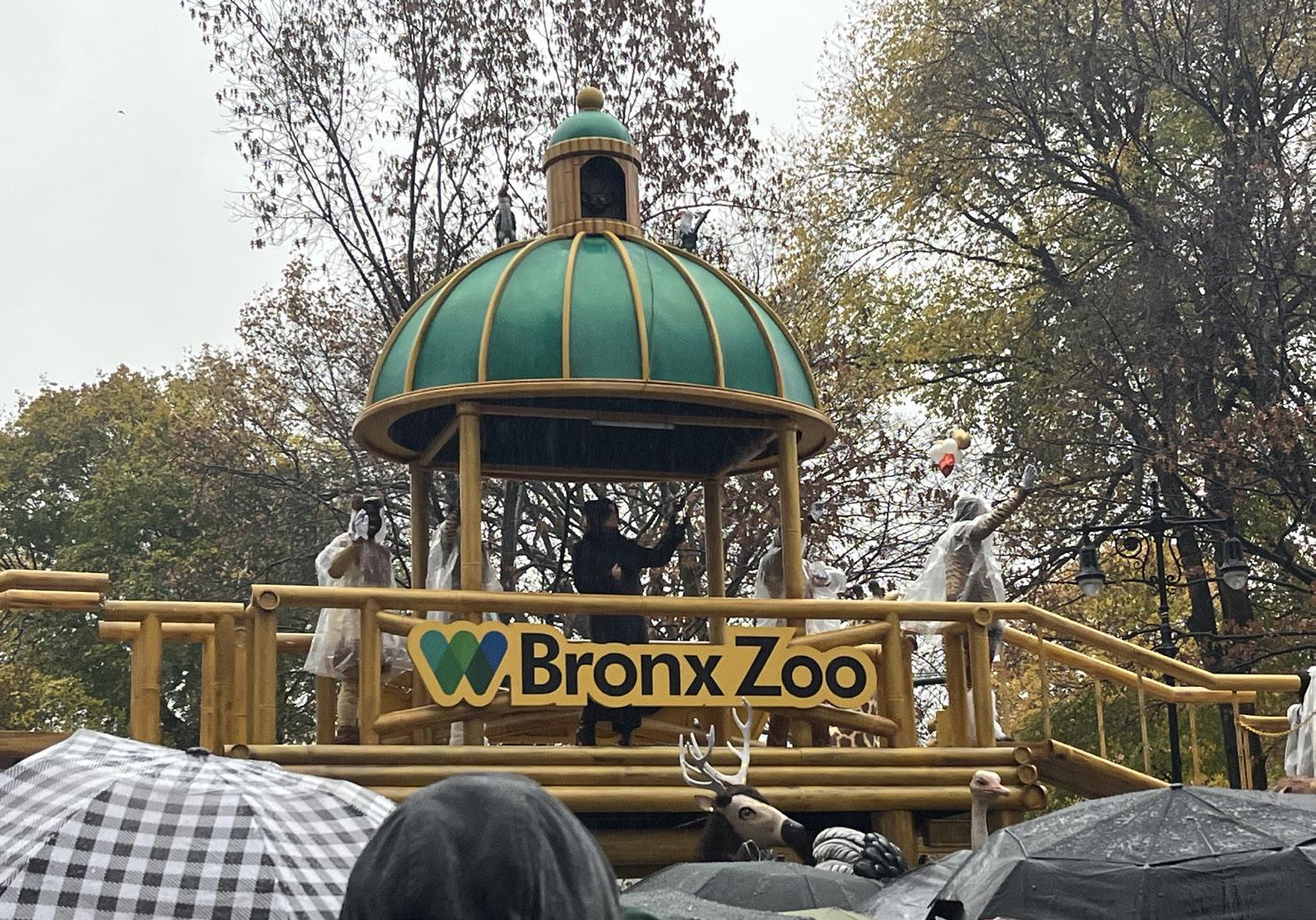
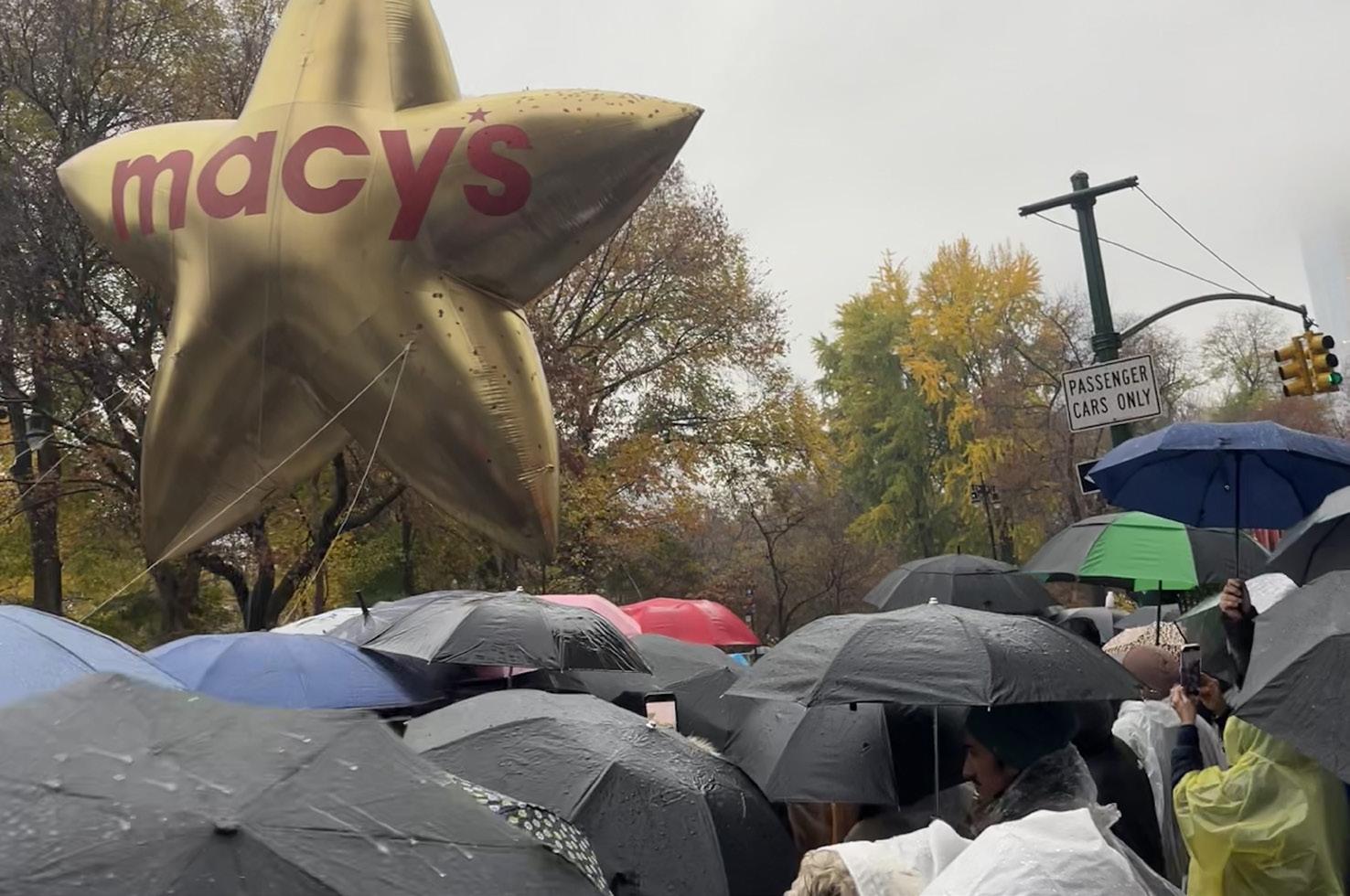
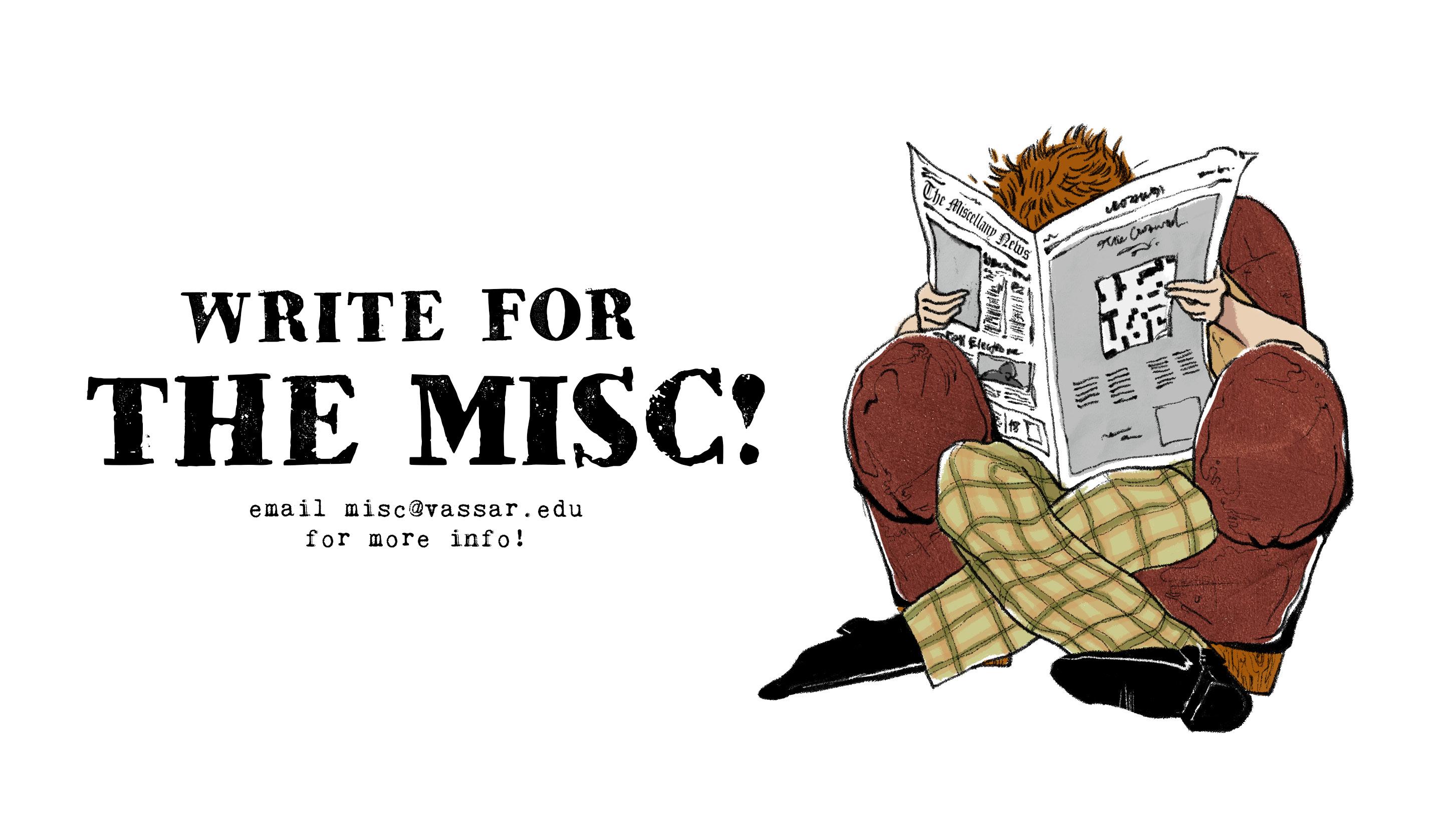
Carolyn Merchant ’58 explores ecofeminism
Lora Janczewski Guest Columnist
On Saturday, Nov. 23, Vassar welcomed an esteemed alumna on Zoom to discuss her work in the field of environmental history and ecofeminism. Carolyn Merchant ’58 is undeniably a role model for those passionate about the sciences, ultimately embodying the idea of using a multidisciplinary approach to solve pressing world issues—a true testament to her liberal arts education at Vassar.
Merchant always had an affinity for scientific research and discovery. Curious about the natural world from an early age, Merchant stated that she had been “absolutely enamored with biology.”
In high school, she began to pursue her inquisitiveness and conduct little experiments of her own. Oftentimes, she would take canning jars and fill them with water from the local pond, letting them rest for just enough time for the various microorganisms to settle into the jar. With an antique microscope from the 1870s, she would peer into the jars and draw the various organisms, labeling and describing them in vivid detail. She went on to submit these visualized descriptions to the Westinghouse Science Talent Search and, after taking an exam, made it as a finalist in the prestigious competition in 1954.
Eager to pursue her interests, Merchant knew Vassar was the place for her, a decision reinforced by her mother, Elizabeth Merchant, who also attended Vassar. Initially, Merchant wanted to study biology, but fearing that there might not be many job opportunities to pursue after graduation, she majored in chemistry. This decision was not solely based on career availability but also on her experience working at Eastman Kodak. Influenced yet again by her mother who worked there, she was able to run a mul-
titude of chemical experiments on film cellulose acetate base. “And so that’s how I came to actually bring my chemical knowledge into practice,” Merchant shared on the call.
Upon attending Vassar, Merchant was actually quite shy. Hesitant to speak up in her classes but aching to participate, she challenged herself to grow confidence, with the goal: “Say one thing in each class.” To guarantee that her engagement in class was compelling, she ardently studied her readings, formulating responses that would impress her professors and surprise her peers. Merchant says, “At the end of one of the classes, a current student who was in the classroom said to me, ‘You don’t say very much, but when you do, it’s so profound.’” More and more, she began to learn that what she had to say mattered and that her thoughts and ideas were worth sharing. “Vassar taught me how to speak up,” Merchant remarked.
Apart from taking chemistry courses required to fulfill her major requirement, Merchant took courses in physics and philosophy, broadening her approach to her field. This multidisciplinary education at Vassar solidified her desire to integrate STEM research with the social sciences and humanities, truly embracing the liberal arts’ message. In merging concepts from philosophy and the history of physics, she blended a multitude of societal and scientific perspectives, propelling her drive in environmental studies and initiating her exploration of environmental history.
In addition to finding confidence through her own achievements, Merchant found endless support in Vassar’s professors and faculty. Coming from a household of only women—minus the childhood tomcat—Merchant found a piece of her home in the then all-women’s college. “The fact that Vassar was an all-women school at the time I attended it
played a major role in my intellectual development,” Merchant claimed. Even just the presence of accomplished women professors inspired Merchant, and it was the authority and passion these individuals showed that stuck with her and decisively played a major role in her future career as an ecofeminist.
Towards the end of her senior year, Merchant was still unsure of what she wanted to do with her studies. She turned to her beloved professors for guidance, who offered her two choices: She could write for a scientific journal or she could go to graduate school. The latter piqued her interest.
After graduating from Vassar with her Bachelor of Arts degree, Merchant continued her studies at the University of Wisconsin, where she earned her PhD in the History of Science in 1967. Merchant went on to teach at multiple institutions, before settling in at the University of California, Berkeley for 39 years prior to retiring from teaching in 2018. During this time, she had a profound effect on her students and departmental colleagues. Carrying the invaluable idea of multidisciplinary approaches to education that she learned at Vassar, she taught a multitude of courses that overlapped ideas in the sciences and humanities—there was no one right way to approach an issue.
Besides her notable teaching career, in 1980, Merchant published her first book, “The Death of Nature,” which became one of the most influential books of the ’80s when it came to environmental action and the proposal of ecofeminism—which is to say, merging the sciences with feminist ideas. The book was so influential, in fact, that Merchant asserted, “Every single bookstore window on Telegraph Avenue had my book in the window.” It explored the Scientific Revolution with respect to environmental costs and women’s rights and continues to
be studied for its commentary on sexism and ecological devastation. She became known as one of the founders of early radical ecofeminism, urging women especially to consider how they can change society itself. How can we get people to think about ways of actually saving the environment? She went on to publish eight other books, with more to come! Ultimately, Merchant urges her audience
In merging concepts from philosophy and the history of physics, she blended a multitude of societal and scientific perspectives, propelling her drive in environmental studies and initiating her exploration of environmental history.
to advocate for the environment when no one else will. Merchant tells the participants, “It’s hard to do, but that’s why we need people to take courses in college to understand how important that is and then to get involved in it.” She left the Zoom call attendees with words of warning, but also hope: “There’s too much pollution, and too many resources that are being just discarded. But the preservation, conservation and restoration movements— the three of them together—are what can help us move forward.” I believe that here, at Merchant’s alma mater, students are fiercely working towards these goals already.
Chelsea Harry updates Aristotelian zoology in lecture
Allen Hale Senior Editor
On Wednesday, Nov. 20, Dr. Chelsea C. Harry, a Professor of Philosophy at Southern Connecticut State University, gave a talk titled “The Concept of Living Well in Aristotle’s Zoology.” The public event was part of the philosophy department’s ongoing Philosopher’s Holiday Lecture series, which features guest speakers presenting their research and on other philosophical areas of speciality.
Professor of Philosophy Bryan Van Norden delivered an introduction to the presentation, noting how he met Harry at a Confucius-Aristotle Symposium. In addition to her academic background, Van Norden highlighted Harry’s involvement with the American Philosophical Association and her work as founder and director of Philosophy in the Schools New Haven.
In a written correspondence with The Miscellany News, Harry described her appreciation for a plurality of philosophical traditions: “While I remained interested in ancient Greek thought, I discovered an interest in the interpretation of ancient Greek themes in 19th-20th century German thought. From here, I became interested in the intersection of classical non-Western thought with German thought.” Her studies later led to a dissertation on temporality in Aristotle and F.W.J. Schelling, a key figure of German Idealism. Resultantly, the lecture combined Harry’s range of passions in Aristotle, the expansion of the philosophical canon and implications for current-day problems of climate change.
Connective constellations between antiquity and contemporaneity began forming early on in Harry’s philosophical education. After enrolling in “The Concept of Self in Western Thought” as a freshman undergraduate, Harry mentioned how Plato’s “Republic” became a favorite text from the class. “I enjoyed the academic challenge of reading Plato’s text, but, more importantly, it opened my mind to the roots of our modern ideas in ancient Greek thought.”
The bulk of Harry’s presentation demonstrated how Aristotle’s ancient zoological work remains relevant to modern audiences, even after centuries of change or overhaul in our scientific conception of the world. Harry began with an examination of eudaimonia, or flourishing, in Aristotle’s ethical thought. Within the “Nicomachean Ethics,” Aristotle argues that living well for humans involves exercising our contemplative, intellectual capacity. This led into Harry’s main question: Does Aristotle have a conception of “living well” as it regards non-humans? If so, how might it be relevant to us today?
When scholars rely strictly on the “Nicomachean Ethics,” Harry mentioned a general conclusion being that animals cannot achieve full human eudaimonia due to their non-human capabilities. What, then, can one say about animals’ unique capacities for flourishing? Owing to the limits of the aforementioned account, Harry’s scholarship examined these concerns by turning towards a greater variety of Aristotle’s writings, including “De Anima” and naturalist texts like “Parts of Animals” and “History of Animals.”
In her reading, Harry picked up on phras-
es resembling eudaimonia in Aristotle’s commentary on animals, like “with regard to living well,” “lives well,” “does well” and “thriving,” echoing the discussion of human flourishing. Despite possessing different capabilities, Aristotle still claims animals have a soul in “De Anima.” Like humans, they possess sensory functions related to desire, serving as a means to continued existence and the pursuit of their well-being. Living well is achieved with regard to naturally-endowed capacities—the speed of a cheetah, for instance, allows them to flourish in their own right. In their attempts to thrive, animals can achieve a quality of life over and above mere existence. If they are unable to exercise their natural character through sensuous or perceptual avenues, physical harm is indicated by traits like color or plumage, as discussed by “History of Animals.”
Promoting the quality of animal life also has the potential to enrich our own, giving us common ground to join other world thought traditions. Compared to the legacy of thinkers like René Descartes—who likened animals to “machines”—pre-modern thought can offer corrective measures to philosophical anthropocentrism. Descartes’ conceptual legacy was noted as being especially prevalent in Western thought. Even if Aristotle was not necessarily making a strictly ethical claim about animal life, Harry claimed his theory can be recovered when articulating an approach to current ethical problems surrounding environmental sustainability. As the anthropogenic climate change crisis progresses, animals’ ability to live well will continue to be impacted by human action, de-
scribed in detail by Aristotelian philosopher Martha Nassbaum’s “Justice for Animals.” In modernizing ancient thought, Harry asserted that we could utilize its viewpoints to begin rectifying our current moral failings as they relate to animal life.
On her end, this claim has not gone unrealized. Harry wrote to The Miscellany News: “In 2023, I was first invited to join the United Nations Development Solutions Network symposia on ancient wisdom in contemporary times, which has given me a new outlet to think and write about the role of ancient philosophy in addressing our most significant global issues, like climate change.”
After her talk concluded, Harry answered a variety of student and faculty questions surrounding topics like non-moving animals, invasive species and artificial environments. The event’s two-hour long duration was split between each portion. Her responses demonstrated a careful concern for each inquiry, often involving extended back-andforth discussion. Harry frequently posed her own questions towards the other speaker, directly asking what they thought; as a result, conversation remained lively.
As a whole, I found the talk to be convincing and clearly articulated, especially regarding its presentation of direct evidence. Ancient thinkers are often ignored or scoffed at, owing to our current understanding of scientific investigation. However, drawing from the “outdated” can be, in pressing times, a new way forward, especially when dominant conceptions of animal life fail to achieve sustainable results. We could still stand to learn something from Aristotle.
Panel marks a decade of Russo-Ukrainian war
On Nov. 18, the Vassar Alliance for Ukraine commemorated the 10-year anniversary since the start of the 2014 Russian invasion of Ukraine, with an educational panel titled, “A Decade of War and Displacement: Humanitarian Consequences of Russian Invasion of Ukraine.”
Valerie Malykhina ’25, one of the four Ukrainian members of the organization, said in a written correspondence, “We’d like to have more support, but the interest in Ukraine has unfortunately died out.” On behalf of Ukrainian students on campus, she added, “It was essential to use this opportunity to highlight how war and prolonged displacement disrupts lives, reshapes communities and demands deeper understanding and complex holistic action.”
Malykhina explained that the Vassar Alliance for Ukraine wanted to highlight the war’s toll on the millions of Ukrainians since 2014, not just since the full-scale invasion in 2022. Both Malykhina and her cohost for the event, Zheka Chyzhykova ’25, have been forcibly displaced from Donetsk by the Russian occupation since 2014.
“Having fled my home in 2014 due to the Russian invasion, it was deeply important for me—and for other Ukrainians—to share the challenges faced by forced migrants and refugees,” Chyzhykova said. “These challenges include discrimination, difficulty obtaining necessary documents, and the immense mental toll of leaving one’s home behind, often with no possibility of return. It felt incredibly meaningful to make our stories visible and heard.”
Yevhenii Monastyrskyi, one of the panelists, is a Harvard University PhD student and a History Lecturer at the Kyiv School of Economics. Monastyrskyi left Luhansk in Eastern Ukraine in October 2014 as a result of the Russian occupation and has since participated in the resistance movement and spent time in captivity. He has worked across international organizations in Ukraine dealing with internal displacement and frontline communities, becoming a historian of the Soviet Union and migration, and serving as the lead researcher at the War Childhood Museum Ukraine since 2020.
Monastryskyi said the Vassar Alliance for Ukraine invited him to participate in the panel dedicated to the 10 years of war and displacement, both internally and externally, for Ukrainians. “It is not an easy task to bring scholars from different institutions to one place for a single panel,” he remarked.
Monastryskyi praised his co-panelists, Director of the Temerty Contemporary Ukraine Program at the Harvard Ukrainian Research Institute Dr. Emily Chennell-Justice, Assistant Professor of History at the University of Connecticut Dr. Sara Silverstein and Associate Professor of History at Vassar College Michaela Pohl. “I believe we managed to touch on most aspects of the topic in less than two hours, covering issues from migration to humanitarian aid, grassroots mobilization of civil society, and historical parallels with other genocidal wars of Russia and its peoples,” Monastryski said.
Malykhina noted, too, that the event held special impact given the many voices in conversation. She said, “What made the event unique was that it brought together both personal narratives and academic perspectives. It’s quite unusual for a small college to have two displaced students from Donetsk, and that gave us a compelling platform for an insightful conversation on the issue.”
Malykhina has lived in Kyiv since 2017
and travels there during breaks. She majors in neuroscience and behavior, focusing on psychological trauma and public health. She spent this past summer at the Superhumans Center in Lviv, Ukraine, an innovative rehabilitation and reconstructive survey center for Ukrainians who endured
amputations and facial injuries in the war.
“In Ukraine alone, there are over 3.5 [million Internally Displaced People], many of whom have been unrooted for over 10 years and experienced repeated displacement,” she said. “By hosting this panel, we aimed to amplify the voices of displaced individuals and foster a greater awareness of the humanitarian challenges that persist in Ukraine and beyond.”
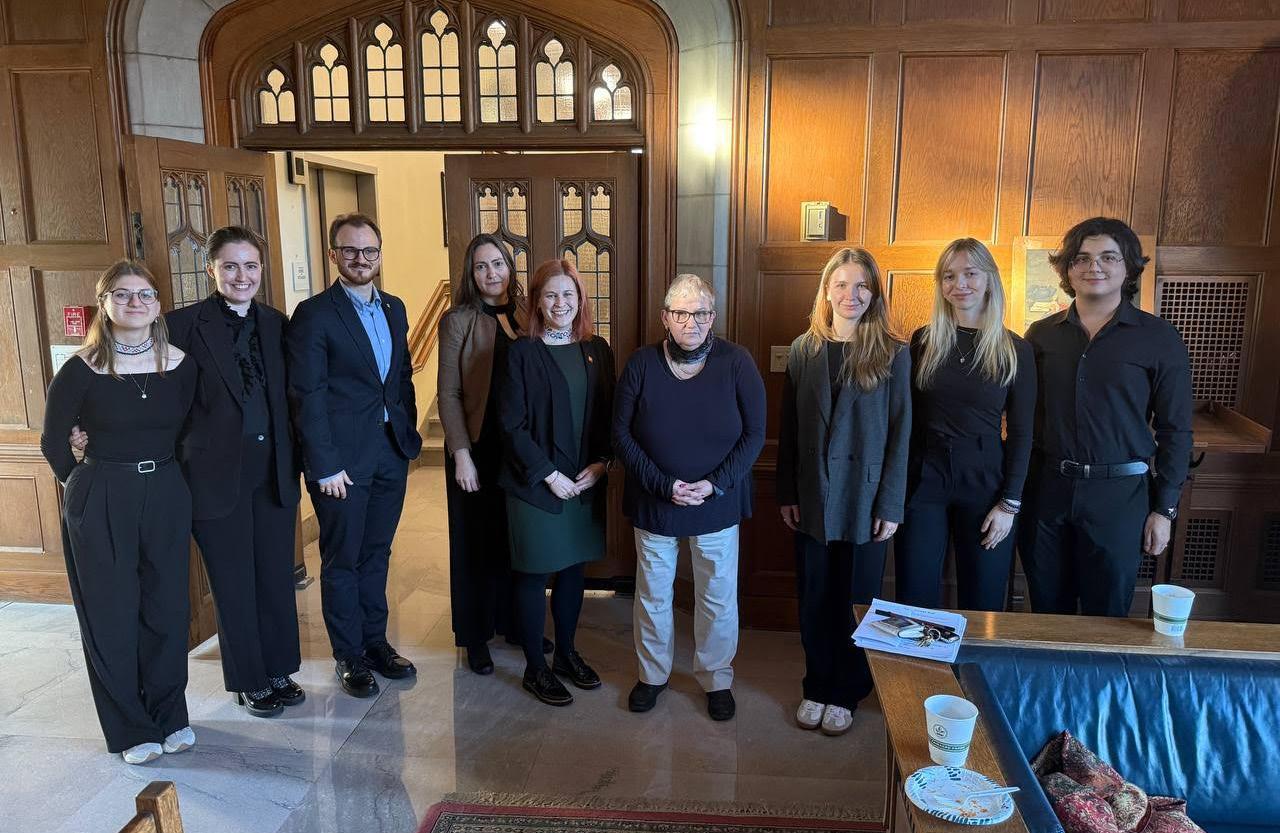
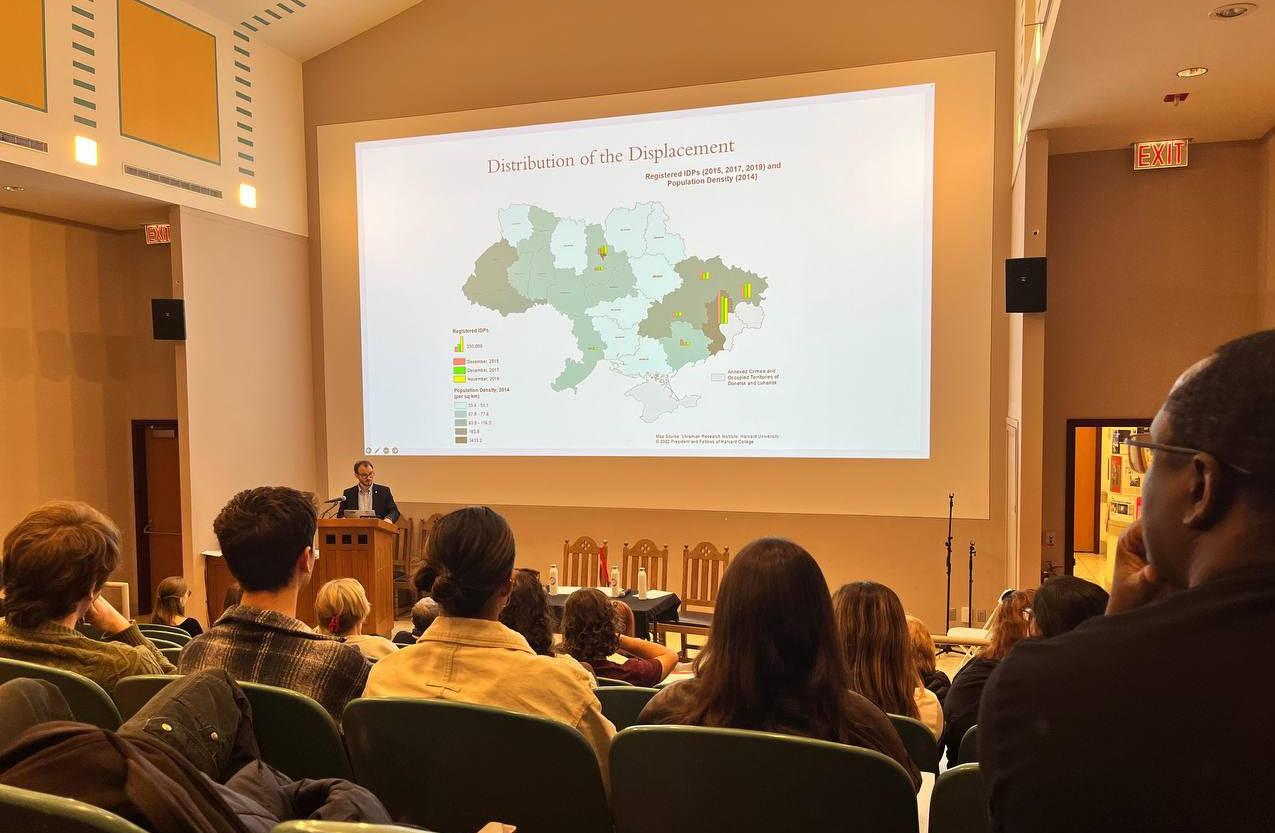
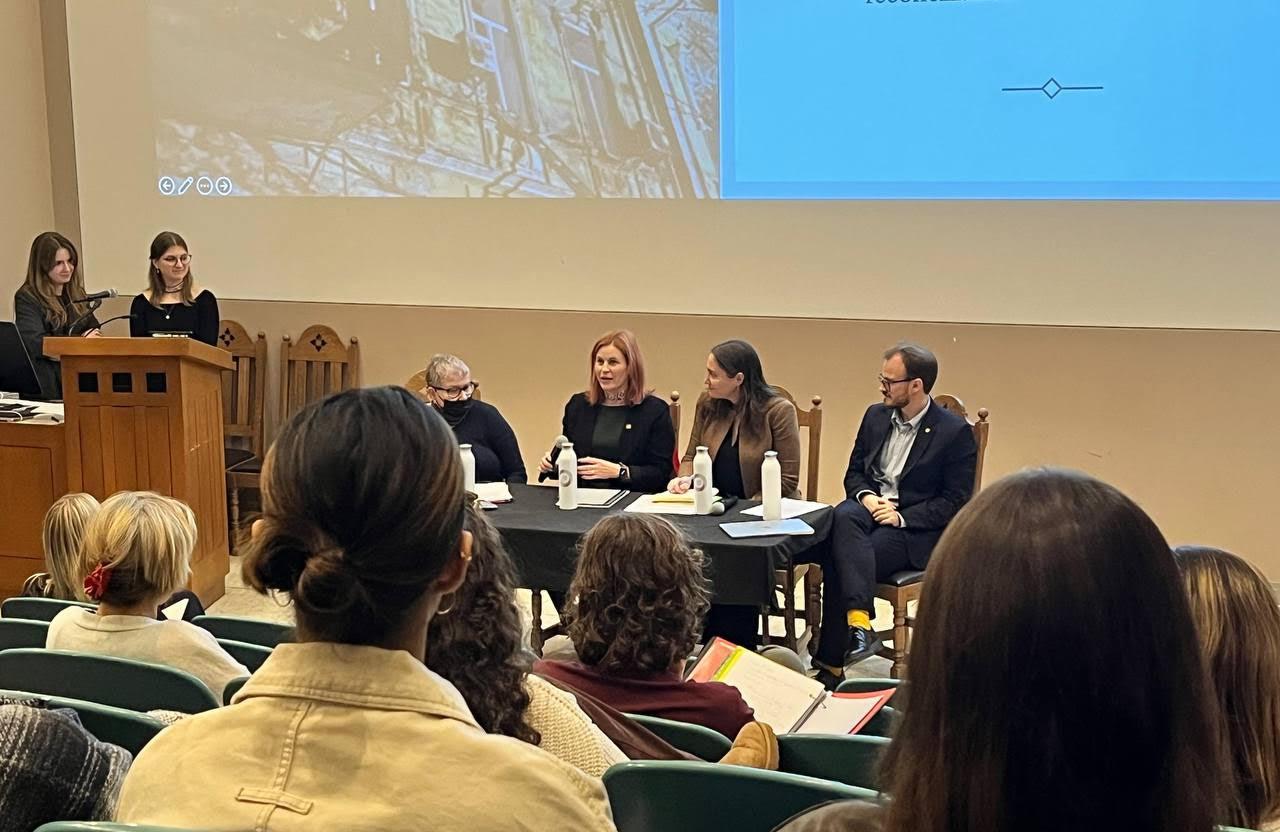
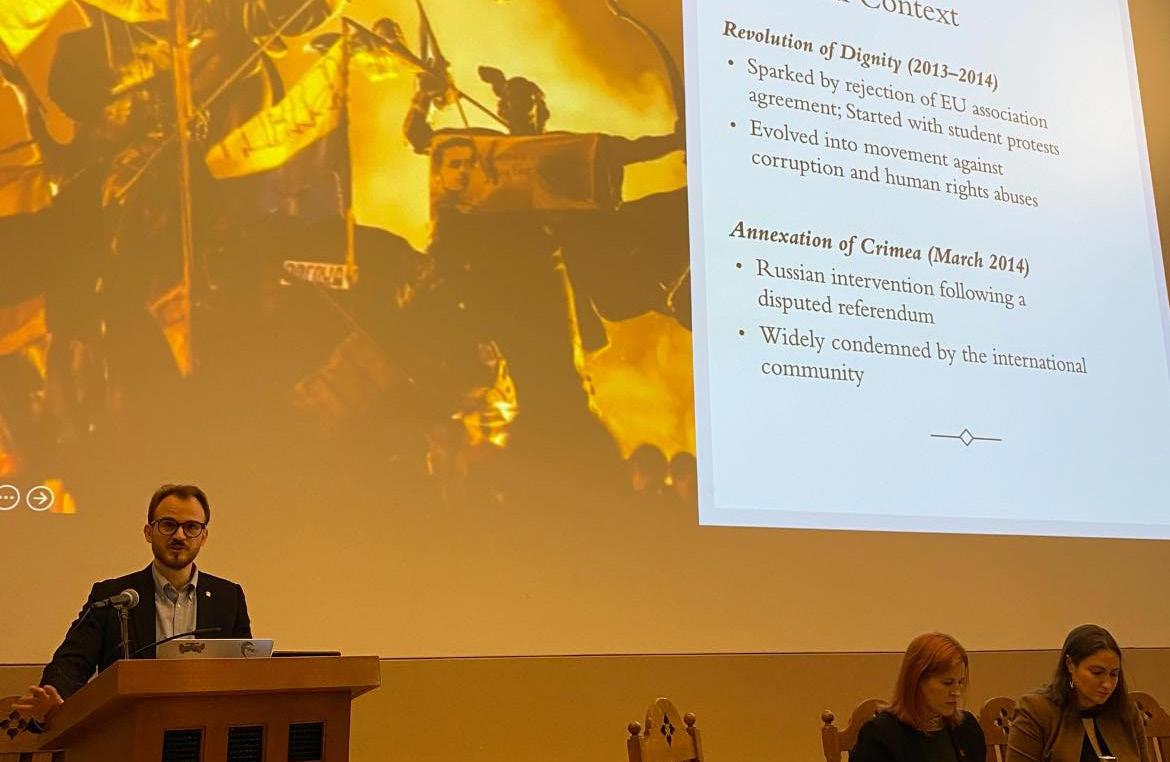
The panel expanded to engage audience members in conversation. Monastrysky, appreciative of the opportunity, said, “Not only did we receive straightforward questions, but even challenging ones resonated with me.” The question of corruption in Ukraine shed light on the Russian information war, according to Monastrysky: “They offer a ready-made opinion, like processed food, denying Ukraine’s sovereignty because ‘it is a failed state.’ People often do not look beyond these narratives.”
Chyzhykova, too, agreed that the question raised important answers: “First, you can always research the organization of your choice and build a personal connection with them,” she said. “Second, if you believe the Western world is immune to corruption and Ukraine is the ‘best’ at it, you are gravely mistaken. Justifying inaction to save lives by citing a slim possibility of corruption is simply another way of shirking responsibility.”
Karolina Naidon ’26, another permanent member of Vassar’s Alliance for Ukraine, is from Dnipro City, where she evacuated in March 2022 due to the start of the full-scale invasion. Over the last two years, she has worked at the Embassy of Ukraine to the United States and the Permanent Mission of Ukraine to the United Nations.
Naidon praised Pohl’s contributions to the panel discussion, noting, “She showed that what Russia has been doing in Ukraine for a decade has already happened in other regions. It was a precise moment when the audience understood that the Russian pattern of military crimes and crimes against humanity has been ongoing for decades.” Naidon also thanked Pohl for her actions on campus: “I am genuinely grateful to Professor Pohl for her continuous support of Ukraine on campus, whether through participation as a speaker at our events or by creating a class about Russian-Ukrainian history at Vassar.”
Jannette Swanson, Director of External Engagement in Vassar’s Center for Career Education, attended the event, both to support students she has worked with and to stay informed about the ongoing conflict. In a written correspondence, she acknowledged the challenge of understanding the history of global conflicts, emphasizing, “Events like this help make this understanding possible and provide me with an opportunity to pause and reflect a bit more on this subject.” She added, “They’ve hosted a number of different speakers and fundraisers and I am always in awe at what our students are able to do in addition to being full-time students ( particularly our students who are from or have family in war-torn countries).”
“I particularly enjoyed how it started with a brief presentation from one of the panelists that provided a historical overview of conflicts that have impacted Ukraine and the impact those conflicts have had as it relates to displacement,” Swanson wrote.
Monastryskyi, the panelists and many in the audience were left gratified by the evening’s events: “While the Vassar Alliance for Ukraine is a small group, organizing something like this demands significant energy from each member, not to mention the effort needed to persuade university administration to support it,” he said. “In my experience at Yale and Harvard, where the Ukrainian undergraduate body is 5 to 10 times larger, it is an amazing achievement that the Vassar Alliance for Ukraine managed to organize such a great panel.”
Breaking News
From the desk of Nicholas Tillinghast
Vassar Wrapped reveals you spent 89,720 minutes at the Bowling TH.
Spending a crazy Thanksgiving with my kooky family
Thanksgiving is a time for families to come together, no matter their quirks or flaws, and enjoy a harvest feast. My family is no exception—but we’re a wacky bunch! Any time we gather, you can be sure that laughs, hijinks and all-around rib-tickling good fun are right around the corner. So without further ado, here’s a play-by-play account of me and my family’s wacky, zany, topsy-turvy Thanksgiving!
8:15 a.m.: My phone alarm went off (it’s set to Pachelbel’s “Canon in D”). However, I did not arise until eight minutes had passed, which is to say at 8:23.
8:42 a.m.: After brushing my teeth and donning my clothes for the day, I enjoyed a Thanksgiving breakfast of scrambled eggs and rye toast, which I accompanied with a mug of hot black coffee. My sister and I discussed current events and shared our thoughts on several recently released films. Breakfast lasted until approximately 9:01.
9:37 a.m.: Once the oven had properly preheated, my grandmother put the turkey in to roast. A good deal of the cooking had been done in the days prior—my family believes in the value of preparation—but there were still several side dishes to make before the Thanksgiving meal. I helped prepare a simple cranberry-based sauce and then spent a shade over two hours doing some assigned class readings.
12:00 p.m.: Ordinarily, this would be
when I would eat lunch; however, as the Thanksgiving meal was scheduled for 2:30 p.m., I did not. I did find myself growing peckish, though, so I ate several crackers topped with a chickpea-based hummus spread. I then returned to my readings until it was time to eat.
2:00 p.m.: My mother, my sisters and I set the table in preparation for the meal, laying out forks, knives, napkins, glasses and, of course, plates. Once the food was ready, we carried it to the table and sat down together to eat. There was some consternation as we tried to fit all the side dishes on the table, but we were eventually able to do so.
2:32 p.m.: Two minutes behind schedule, the meal began. Everyone thoroughly enjoyed it. They say the best accompaniment for good food is good conversation, and in this case, I can certainly attest that that principle held true. We discussed a number of topics, including our favorite Thanksgiving foods (I am partial to stuffing), the weather (it was cold) and the water heater (it had recently been replaced). We were all very full after the meal, so, after cleaning up, we rested for a while before returning to the table for dessert.
5:18 p.m.: For dessert, we had pie. There was an apple pie, a cranberry tart (which is not, strictly speaking, a pie), and a pear-pomegranate pie. The lack of Thanksgiving classics like pumpkin and pecan may surprise some readers, but what can I say—we’re crazy that way! Everyone had a slice of each, and they were all delicious.
6:33 p.m.: After dessert and another round of cleanup, we gathered to play the popular
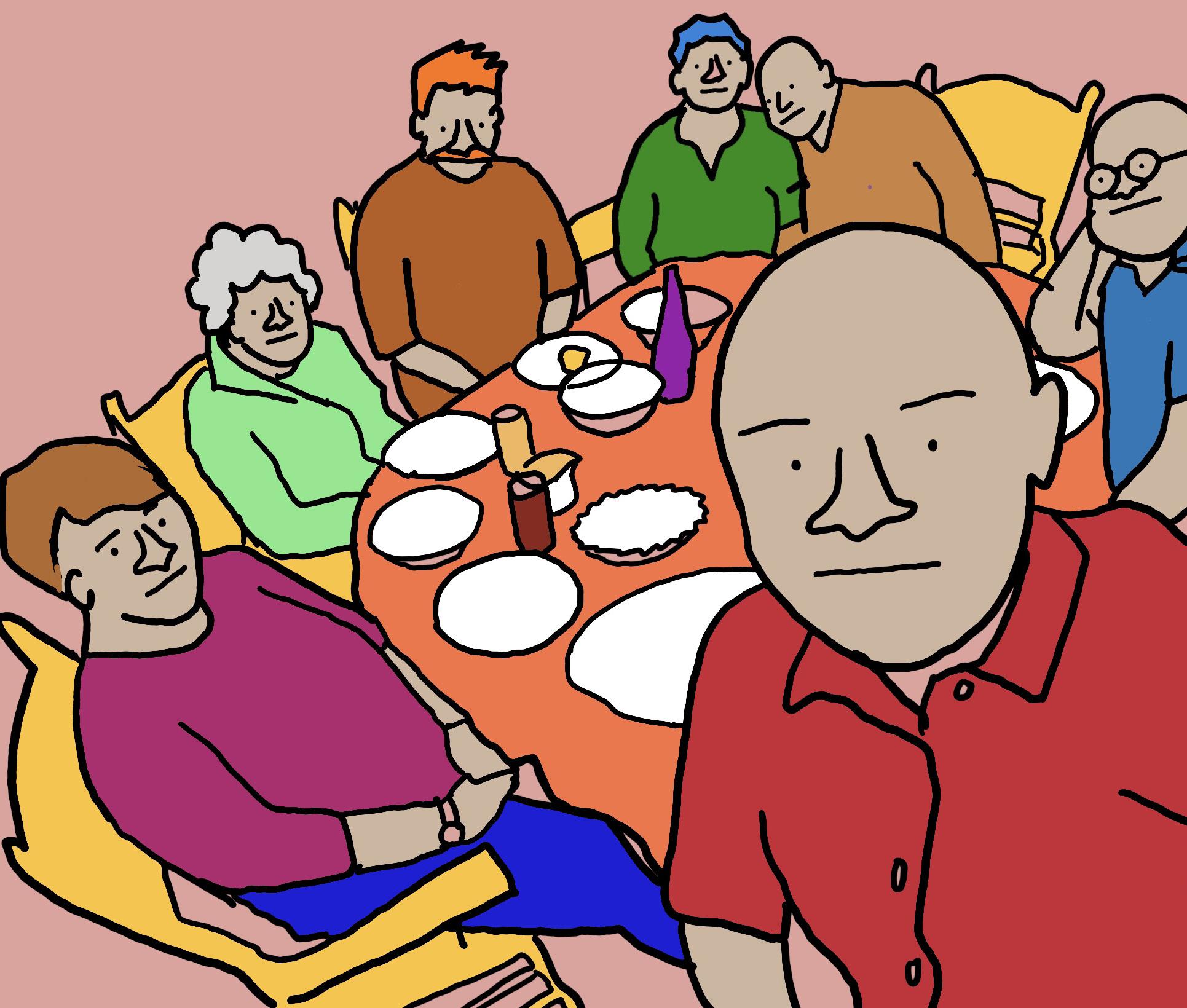
party game “Apples to Apples.” My father won. Overall, it was an enjoyable experience, but I was mildly perturbed when my card, “Angry Hornets,” was not selected as the best answer for the prompt “Emotional.” This struck me as somewhat unfair because the hornets are explicitly defined as experiencing anger, which is, of course, an emotion.
8:08 p.m.: Several members of my family went to bed after “Apples to Apples,” but those of us still standing decided to watch some TV. We watched two episodes of the science fiction series “The X-Files” (we have been slowly making our way through Season One) before
even the strongest among us began to tire. At this point all agreed that there was nothing to be done but fall asleep, so we said our goodnights and split off to do so.
9:55 p.m.: I brushed my teeth, put on pajamas and got into bed. Once there, I looked at my phone for a few minutes before putting it away and closing my eyes to sleep at approximately 10:03 p.m.
Well, folks, that’s it—the story of my Thanksgiving. I bet you’ve never heard of one quite like it! That’s just how things are with my family. We’re always doing things the wacky way!
Pokémon Go take this quiz!
Nandini Likki
Ugh, I Just Don’t Know!
Hi! Oh my god, you again? Why do you keep coming into my office when you don’t need any career advice? Didn’t you already get hired a couple months ago? How many times do I have to tell you that this is a SERIOUS place for SERIOUS career counseling? I have a million computer science majors coming in an hour, so you need to get out of here.
Sigh. I’m sure there’s some garbage lying around that you can play with while I call security. Here, take this quiz:
Question 1: Where did you and your boyfriend meet?
A: In a regular place like a cafe, bar, gym, etc.
B: I was just a dedicated fan! His beautiful, crackly voice captivated me as he struggled to do different voices for NPCs.
C: I don’t have a boyfriend.
Question 2: What do you admire the most about your partner?
A: He’s so sweet, dependable, caring, honest, hardworking. He’s everything I could ever ask for. And I love how he bounces on it with no hands.
B: Bro is the best min/max gamer I know and his rizz is frictionless. Don’t tell anyone this, but I’m pretty sure he wrote Pokémon Uranium.
C: Again, I’m not dating anyone right now.
Question 3: Where do you see your relationship in five years?
A: I don’t want to be premature, but I definitely see a ring in my future!
B: I hope he takes me to Los Angeles so we can go to E3 together and practice our Japanese while we’re waiting in line to see Oshawott, my favorite Pokémon. I know water types aren’t super popular but I think they’re really underrated and—
C: I hope I can at least BE in a relationship in five years.
Question 4: How would you describe your ideal date?
A: Honestly, any time that I get to spend with
him is magical and romantic.
B: We pull out the Pinot noir and light some candles. Playing on the TV is…PeanutButterGamer, our favorite YouTuber.
C: They have a pulse and are breathing.
Question 5: If you had to describe your partner in one word, what would it be?
A: Effervescent.
B: Prepubescent.
C: Nonexistent.
If you answered mostly As…you love him! That’s for sure. You love him a lot. Like so much. It’s kind of crazy how much you love him. Does he love you? Who’s to say? Maybe he doesn’t love you at all. The important thing is that you definitely 100-percent love him.
If you answered mostly Bs…you’re still hoping to be featured on his Pokémon Let’s Play Channel from middle school! Although he hasn’t posted videos on there in five years, you’re still holding out for the dream of one day collaborating with Pikaturd96 and playing Emerald together. Keep your head up! If you consistently spam him on Instagram, he
might reply one day. If you answered mostly Cs…you should watch Daniel Sloss’ “Jigsaw.” The world is so amatonormative these days. Every Disney princess ends up in a relationship. You can be super close friends with someone your whole life, but the second they start dating some random guy, you become Plan B. We use phrases like “forever alone” and “doomed to be single.” Leave your house and smell the flowers. Eat a sandwxich. Write a poem. You don’t need to be in a relationship. The world is so much more than it seems. Peace.

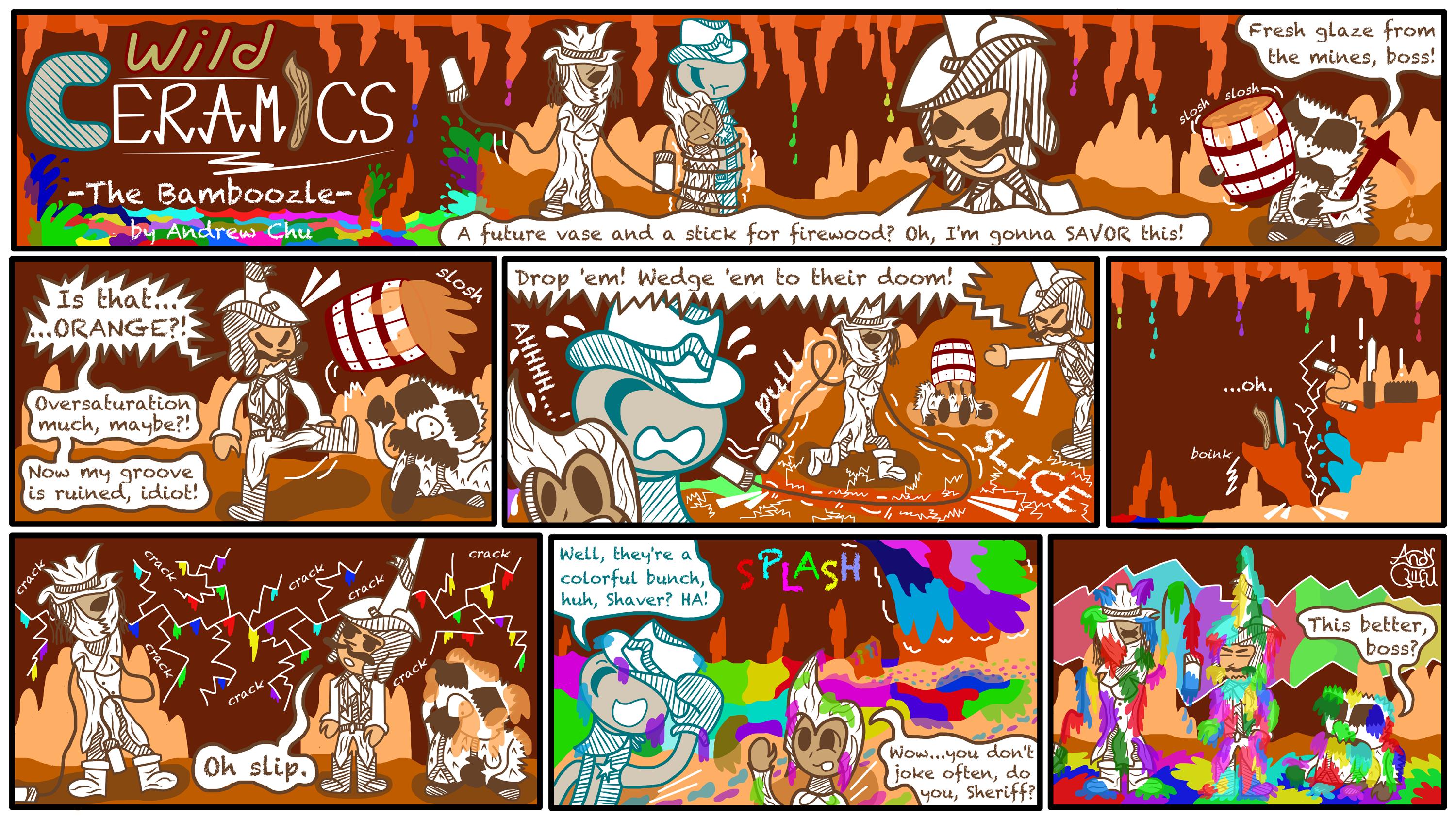
Post-Thanksgiving revelations while three feet deep in snow
For Thanksgiving, I went back home to the distant suburbs of Buffalo, New York, a place snowy on a level that Poughkeepsiites simply don’t understand. Last Saturday, I wanted to go see the movie “Conclave,” the one about all the Catholic guys, but the roads were so snowy in Buffalo that I couldn’t drive 40 minutes out to the Regal multiplex.
I ended up spending a lot of time at home working on school stuff. One thing I really like about being home is that there’s food in the house. This was exceptionally so because we had Thanksgiving leftovers. At the TH, we’re lucky if more than half of our fridge has stuff other than the alcohol. No shade on alcohol, but nothing quite satisfies hunger like food.
I have hard time believing anyone who tells me that they got a lot of school work done and had a good break. Those two things are incongruous. I’m saying that as someone who got some work done and
had a somewhat decent break (very congruous). I started this article on Friday, when most years I frantically write my post-Thanksgiving piece Sunday on the train ride back (couldn’t have even done that this year, the train got canceled).
As a halfway decent break implies, I did enjoy parts of it. I walked downtown on Black Friday and went to two cavernous antique stores. One of them had a cavern dedicated to 200 or so childrens’ dolls lined up on shelves. I didn’t buy anything there. Later that night, I met up with a friend. We trudged through a foot of fresh snow just to get from my house to the car, our footsteps muffled by the first 12 inches of lake-effect snow. While we were eating dinner at a restaurant, he told me that he works in the sports section of Walmart now—more specifically, the firearms counter.
He also told me that for Halloween this year, he dressed up as pregnant Garfield, which I thought sounded like a pretty nifty idea. Of course, the only place that he wore his Halloween costume for one oc-

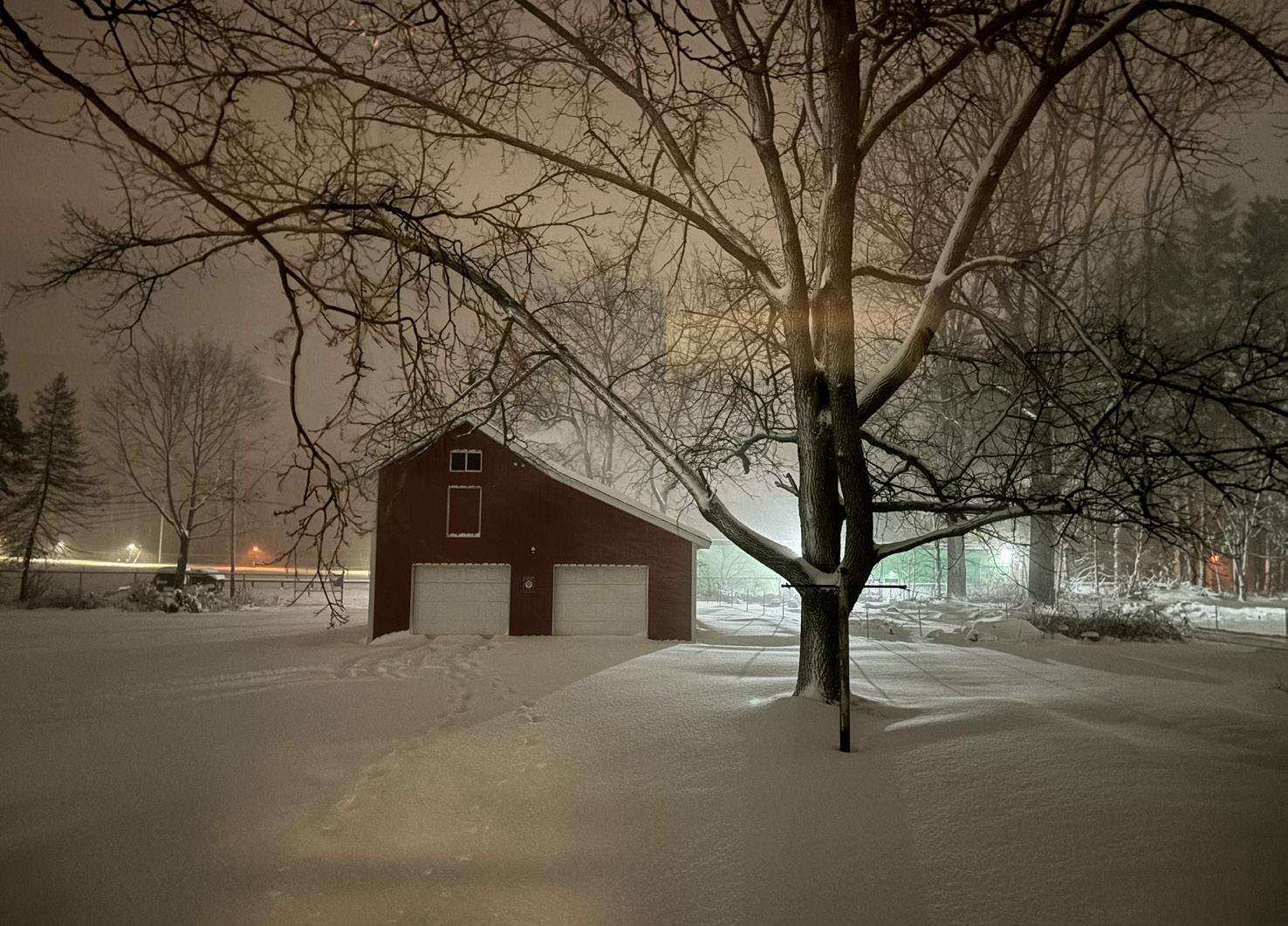
casion: work, which, might I remind you, is the gun counter at Walmart. The most frequent question he got that day of course was not, “What kind of gun should I get?” or “Are you dressed as pregnant Garfield?” (which of course, would be rude, as you really should never ask someone whether or not they’re pregnant). It was, “Do you work here?” with the obvious answer being, “Yes, of course. I am Garfield. And I sell firearms at this Walmart.”
You might be wondering at this point: Why was he dressed as specifically pregnant Garfield and not just regular Garfield? To this I’d say, technically he was essentially dressed up as regular Garfield, but he specifically bought and wore a pregnancy belly costume underneath the costume to fill out Garfield’s dimension, so I think it’s fair to call him a pregnant Garfield.
Why a pregnancy costume? Well, Garfield is a corpulent cat, so it’s worth trying to fill out his figure in a costume. My friend told me that a traditional Santa-style fat suit was too burly for Garfield, and that a classic pillow under the Garfield onesie looked too boxy. So he bought a fake pregnancy belly, specifically a five-to-seven-
months option. This was a cheaper variant than the eight-to-nine-months and noticeably more visible than the three-tofour-months bump. Simple maths really. If you’re going to fake a pregnancy bump, it might as well be cheap and visible.
I would agree that of all these options, Garfield’s build most resembles a pregnant woman in their second trimester. If you were not well-versed in Garfield’s silhouette, you might easily assume the costume was depicting pregnancy, but again, one should not assume. That’s up to Garfield to decide if and when he decides to announce such a thing.
Last year, I watched this documentary about O.J. Simpson, the guy from “Naked Gun,” that compared playing football in Buffalo, New York, to being exiled to Siberia, and I haven’t really gotten over it. I didn’t really notice how oppressive snow is in Buffalo until more recently when I became an adult that wants to do things that involve driving, but it’s very true. I’m not O.J., I’m not from California, and I’m not a flashy football player, but I’d like to be able to go to the multiplex when I go home for Thanksgiving.
HUMOR
Biden accidentally pardons turkey guilty of first-degree murder
Wren Buehler Ambassador to Turkey
Controversies abound in Washington this week after an investigation revealed that “Blossom”—one of two turkeys pardoned by Joe Biden this year—was a convicted murderer, robber and polygamist. Biden has expressed his regrets over the decision in a recent press conference.
“I fucked up big time,” the President said. “I wish I could say that we as Americans must not live in fear. But I’m gonna be real with you guys—living in fear is probably your best option right now. In a just world, Blossom would be dead. I ask you to forgive me for making this world an unjust one.” When asked what the federal government will do to stop Blossom, Biden said, “Nothing can be done. When you pardon a turkey, it retains legal immunity until death. It’s one of those old-timey constitutional mistakes, like the Second Amendment.”
Hunter Biden was especially distraught to hear the news, asking, “What does this say about me? I mean,” he said, pausing for another line of cocaine, “he pardoned a murderer before his own son!” After a five-minute hooker break, Hunter concluded that his father had acted “totally
unprofessionally. But then again, he’s always been the screw-up of the Biden family.”
An anonymous source within the White
House revealed that Biden’s team has been thrown into chaos by the announcement.
“The American populace will never support a political party that aligns itself with convicted
criminals,” said one staffer. Another worried that “things are looking bad for Biden 2028.” Asked to comment, Blossom said simply, “I will kill again.”

‘Wicked’ sweeps theaters, floors audiences
Josie Wenner Defying Gravity
Ihaven’tseen “Wicked.” This is just what I think will happen.
“Wicked” is a sweeping and epic story about the love between two friends and lengths one of them will go for the other. Cynthia Erivo and Ariana Grande are breakout stars, but the contributions of Jane Blipdorf are not to be understated. Overall, “Wicked” is a fantastic film made for and by fantastic people.
The movie opens up with Elphaba (Cynthia Erivo) taking her sister Nessarose (Marissa Bode) to boarding school. Elphaba’s skin is green, and she faces bullying and harassment over it. Erivo’s dedication to the role is incredible. She underwent surgery to get her skin to be the exact right shade of green needed to play Elphaba. Erivo’s beautiful singing voice and commitment to her craft elevate the movie to new heights.
When Elphaba arrives at school, the principal is awed by her talent and begs her to stay. Elphaba reluctantly agrees and is assigned the perky Glinda (Ariana Grande) as a roommate. While the two chafe at first, they eventually bond, with the power-ballad “Popular” cementing Glinda’s desires to help her new friend achieve popularity and therefore be worthy of her affection.
As Elphaba and Glinda grow closer and closer, Glinda sees the bullying her friend is subjected to because of her green skin. Glinda then thinks back to the time she posted a black square on Witchstagram, then vows to do more this time around: She will turn her skin green in solidarity with Elphaba. Grande’s comedic timing in this scene is impeccable. She proves that she can do more than just sing and be small with long hair: She’s a stellar comedian as well.
Glinda hunts far and wide for a spell that can do what she wishes. She finds one in a magical book called “I Green Myself” by Ozbias Fünke. She finds her ingredients: a blade of grass, a newt’s tear, an unripe banana, a cat hair and a spool of thread. The only thing she’s missing is a drop of blood from a greenskinned person. Glinda attempts to steal El-
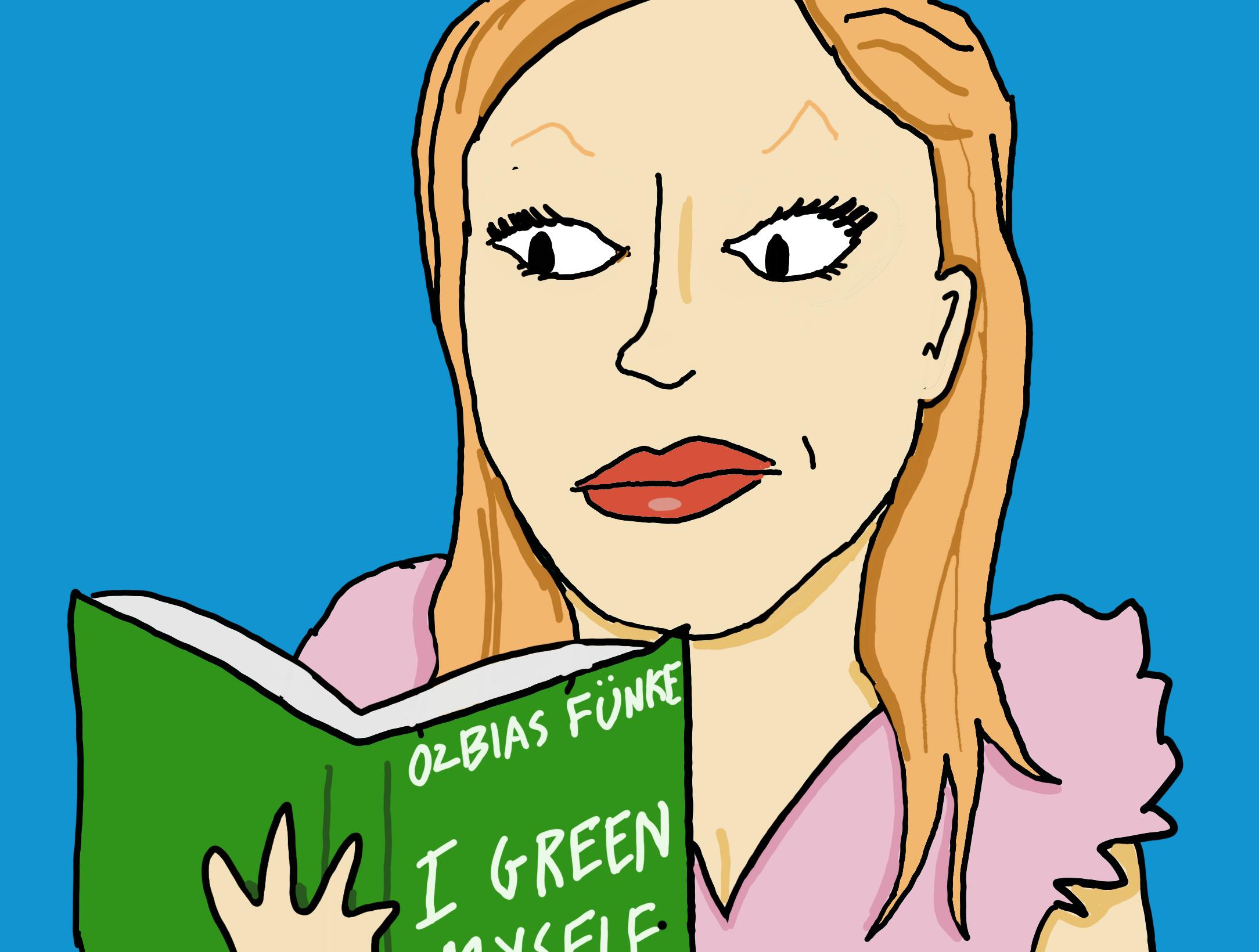
phaba’s blood while she sleeps. Elphaba wakes up to Glinda holding a needle and a test tube, and is understandably shocked and hurt. Glinda pleads with Elphaba and explains her plans. Elphaba is confused, and doesn’t understand why Glinda would willingly subject herself to the struggles of being green. However, she is won over and is overwhelmed by Glinda’s compassion. Grande’s dulcet tones serve the song “Green Girls” well, and the heartwarming emotional climax of the film swells as Elphaba tearfully embraces Glinda. Glinda recites the spell’s incantation, and Elphaba watches with bated breath. Unfortunately, Glinda’s attempts to turn her skin
green go tremendously awry. While she becomes a brilliant jade hue, the spell malfunctions and a puff of smoke envelops Elphaba and Glinda. As the smoke dissipates, a figure emerges. The spell has inadvertently created a clone fusion of Elphaba and Glinda akin to the situation in “The Substance” (which I also haven’t seen). This new character, Gelphaba (Jane Blipdorf), vows vengeance upon her creators and swears to take all of Oz over as her own. Gelphaba cackles wickedly, then disappears with a sweep of her cape. Although Blipdorf had a mere five minutes of screentime, she managed to remain the movie’s third-most impactful character. She domi-
Nicholas Tillinghast/The Miscellany
nated the screen, prowling menacingly to and fro and laughing an evil laugh. I’m eager to see what part two holds for Gelphaba and sure that Blipdorf will continue to deliver.
The movie concludes with Elphaba’s iconic song, “Defying Gravity.” Erivo delivers a powerhouse performance as her character promises to hunt down Gelphaba and stop her tyranny. Glinda gives her a sorrowful wave goodbye and plans on returning to the Emerald City to warn the citizens of Oz of the threat Gelphaba poses. Overall, Erivo and Grande prove to be every bit the dynamic duo as expected, and deliver a film packed with promise, love, heartbreak and green.
OPINIONS
It is indoor season, and I hate big lights
Zoe Rodriguez Guest Columnist
The first snowfall of the season is an early sign that we will be spending much more time indoors. When it starts to get dark at 4 p.m., we are forced to crawl back into our dorms and recreate a semblance of light, or else we end up in a gloomy hobbit hole. The tiny ration of light we get these days is becoming smaller, and we need all the light we can get. This means confronting my worst enemy: big lights.
What do I mean by “big lights?” I mean those blaringly white overhead lights which are the default in most indoor spaces, creating that perfect “dentist waiting room” aesthetic. They are painfully artificial, and to be honest, I would rather just sit in the dark than under the blasting spotlight that is the “big light.”
I am not the only one who hates this. According to The Washington Post, the term “big lights” started on social media and is used to refer to all kinds of overhead lighting, like mount domes, ceiling fan lights and even chandeliers. One audio, which refers to a soundbite on the platform TikTok, went viral with a creator saying, “I don’t have many rules for my house, but I do have one, and that is that we never, ever, ever, ever, ever, ever use the big light.” The quote was accompanied by videos of people showing off their different lamps and how they avoid using their overhead lights. A sort of interior design movement began, as people could finally put their finger on what felt off about their rooms: the big fluorescent light on their ceiling. It has this oppressive glare, beating down on the room and creating ghastly shadows. It is not just about the way big lights make the room look, it is more than that. It is about mood. It makes me feel like I am produce on the shelf in a supermarket waiting to be bought, or like I am waiting in line at
7-Eleven. It is uncomfortable. If these overhead lights are so abrasive, why are they everywhere?
An article in The Washington Post says it is partly because of profit, and that building these lights into homes is just the cheapest option. The article also mentioned that overhead lighting was a remnant of history, stating, “A fixture up high sheds light more broadly … which is helpful if you’re relying on an oil lamp or a chandelier.” Overhead lighting is basically just the next best thing we could come up with after candles. And it is the worst.
Are there any pros to the big light? It is not universally hated. It is more functional and offers greater coverage of the room, more suited for a larger number of guests and more practical for a workspace. However, the big light does not only have aesthetic faults: it also has physical effects.
Medical professional Dr. Mariana Figueiro says, per The Guardian, “the amount of light that enters your eyes triggers and regulates the circadian cycle … so it’s best to have light at eye level, because … light actually reaches your eyes.” This eye-level lighting is more conducive to being focused and alert. She goes on to say that fluorescent overhead lights do not accurately mimic natural light, because surprisingly, they are dimmer than sunlight. Lights that already feel way too bright may actually be fainter than natural lighting. This creates a “continuous twilight” effect, confusing our circadian cycle. The next time you walk into a room and the whole space feels artificially bright, it may be because the overhead lights are technically dimmer than you are used to.
So how should you light your dorm, home or living space? It is best to start with warm lighting, instead of white. In a similar article from The Washington Post, psychologist Jennifer Veitch says warmtoned lighting is relaxing, and it primes
us to socialize. Warm lights feel cozy and welcoming. The next step is to get rid of the big light. As a Noyesian, I love the unique spherical light fixture hanging from the ceiling in my dorm room, as it makes the room so much cooler. Unfortunately, it still has that overpowering effect of a big light. It has become a decorative staple of my room, and as a replacement, I believe in the power of lamps. There are so many possibilities. Victorian lamps with beautiful lacy fabric, modern floor lamps with curving spines and cool geometric bulbs, or even stained glass lampshades with intricate mosaic patterns. The alternatives to overhead lights are so much more interesting. When using warm lighting it is imperative to “layer” the lights, according to interior designer Young Huh from the previously mentioned Guardian article. “Layering” light sources means having
some light on the floor, some on desks and shelves, and some mounted on the wall, creating a “soft glow everywhere,” as she refers to it. This keeps the room cozy and well lit, even without an overhead light. As college students, our decor is limited and we cannot be world-class interior designers. The lighting of our rooms is far from our biggest priority. But with dreary winter days right around the corner, ditching the big light can make a difference. Using simple tricks like warm lighting, stylistic lamps and “layering” light can transform our spaces from glaring interrogation rooms into spaces that feel calm and inviting, physically and mentally. Turning off the big light can make studying, socializing and even sleeping feel more natural. It is one of those little things you can do to brighten your mood, with only the flip of a switch.
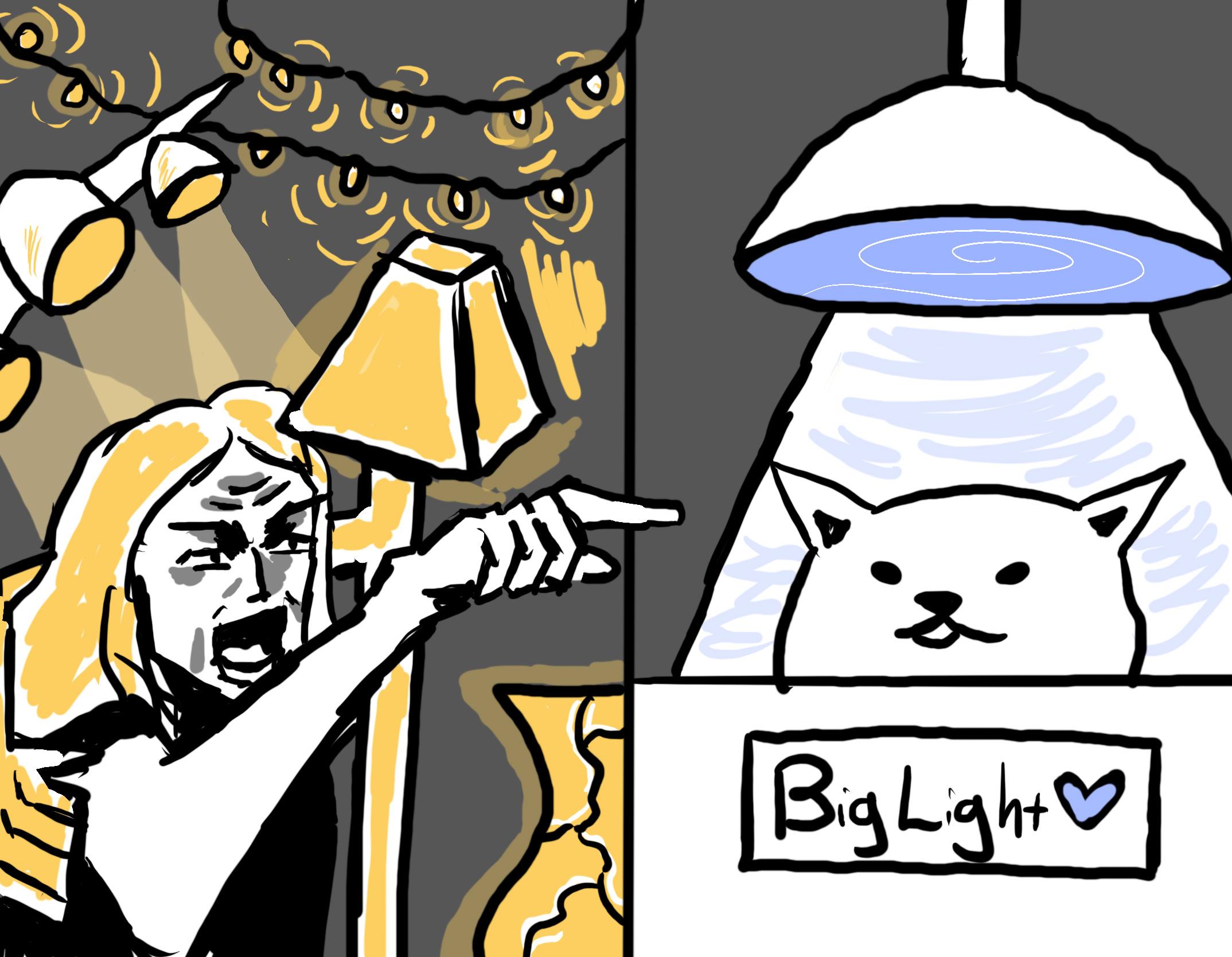
Democrats are losing minority voters
The future of MAGA may be more multiracial than we thought. The Republican Party’s ticket has won with gains in every voter demographic, including nonwhite minorities. While President-elect Donald Trump can still attribute his victory to the white male vote, his gains with non-white groups, according to the Associated Press should not be ignored. Many are asking, why did so many minorities vote for Trump this year? I found that Trump’s success with minorities, and the discourse it generates, are indicative of larger flaws in how politicians and commentators discuss race and voting.
The category of “minorities” is not a monolith. The term refers to so many ethnic groups, regions and political beliefs that it can be problematic to lump all into a single voting bloc. Americans are diverse, and their ideologies can be just as diverse. The voting choices of anyone can depend on their worldview. Worldviews are shaped by individual factors like location, history and socioeconomic status. Black people in rural areas may vote differently than Black people in urban areas, and even within those two categories there will be variation. However, by categorizing voters collectively as “minorities” or even by group, that individual variation is erased. The two-party system also simplifies the exact
wishes of all voters. Rarely do either of the two candidates line up with every single belief we may have, but we must always choose one in the end. Our habit of lumping minorities together in data, combined with polling limited by the straightjacket of the two-party system, creates a categorization system of race that is highly warped.
While racial polling alone seems like a small concern, the effects of it can be seen in larger politics. In the news coverage, it is treated like a shock that so many Black and Latino voters supported Trump. It is true that these groups have typically been won over by Democrats in the past. Even this year, despite losses, the majority of both groups still voted for Kamala Harris.
According to The Atlantic, Trump has a very long and public history of insulting Black and Hispanic communities. There exists a mainstream narrative that because of historical statistics and the racial hostility of the GOP, minority support for Democrats is simply a given. It is not. I am suspicious of the idea that any party is simply entitled to the votes of a group of people. It is a generalization that has been disproven by the non-white voters who helped Trump win this election.
The Democrat Party’s entitlement to minority votes reveals itself in the statements they have made. During the 2020 election, Joe Biden gave this damning soundbite: “If you have a problem figuring out whether you’re for me or Trump, then you ain’t
Black.” And during the 2024 election, according to Brookings.edu, Barack Obama caught backlash for chastising Black men who were not voting for Harris at a rally. I am not bringing this up to deflect attention from the more overt racism of the political Right. But acting entitled to a population’s vote is a kind of racism in and of itself, one that those voters are well aware of. It is condescending and can certainly build resentment.
The Democrats’ poor handling of race extends to policy as well as optics. Before this election, Arab Americans reliably voted blue. But in addition to inflation and immigration concerns, the United States’ backing of Israel’s wanton violence in the Gaza Strip has clearly turned away these voters. In Dearborn, Michigan, where more than half the population is of Middle Eastern descent, support for Democrats dropped from 70 percent in 2020 to 36 percent in 2024, according to VOA news. The rest of their votes went to Trump and Green Party candidate Jill Stein. The lack of a ceasefire deal or an arms embargo is seen as a failure on the part of the Democrats.
Trump and Stein are not viable options for achieving peace for Palestinians. According to The New York Times, Trump has a history of openly backing Israel. Meanwhile Stein’s campaign is, according to Urban Milwaukee, more of a saboteur-funded publicity stunt than a serious contender. But Harris has been a part of the Adminis-
tration that keeps sending arms money to Israel. Since the Democrats proved they didn’t support Arab Americans, they lost Arab Americans, despite how dangerous or useless the other candidates were.
As the fanfare of victory dies down, it’s difficult to say if the GOP will be able to keep the non-white voters they have gained. Within the Republican party, nonwhites are still outnumbered by whites, and their interests will not be represented equally with white interests. However, the Democrat coalition hardly treats minority interests equally either.
Politicians, pollsters and journalists should revise expectations toward the political behavior of minorities.

Women’s XC enjoy historic season, NCAA bid
All Region runners—Schoenegge, Reade, Nyhan, Kaigle—and a silver medal for Schoenegge.
After their run at regionals, the women were confident they had done enough this season to clinch a ticket to nationals. The next day, it was announced that the Vassar women’s cross country team would be competing at the Lavern-Gibson Cross Country course in Terre Haute, Indiana at the NCAA National Championships.
After hundreds of miles, tough workouts, wins and losses and lots of hugs, the team achieved their ultimate goal. Now, as national qualifiers, all that was left to do was compete—for each other and the program. Nyhan reflected on the team’s journey, sharing, “Coming into this year, I think there were a lot of expectations of doing that again and wanting to do that again. However, every season is different and you’re never going to replicate one season over again. Last year we really had a strong beginning and middle season. We really created a resume that got us to nationals when we didn’t have the performance we wanted at regionals.” Nyhan emphasized, “This year
we didn’t have that same trajectory, we took a little bit longer to build up through the season and figure some stuff out. We were then able to have a really strong performance at regionals which was what allowed us to go to nationals.”
Finally, race day arrived. The snow from days prior had melted and the course was ready to challenge 293 of Division III’s fastest women. The course consisted of rolling hills and opened up with an opening chute that was a one-kilometer-long straight stretch, an unusual feature on a cross-country course. It was a difficult course; however, it was nothing the Brewers could not handle.
Nyhan shared that the team felt slightly nervous entering the race: “There’s a lot of people at nationals and a lot of other competitive teams. We’ve been at races before that have a similar number of people, but not that many people at that level. There’s not another race like it and there’s not really a way you can prepare to experience that kind of a race.” Competitive meets like regionals and certain invitationals create intense atmospheres, but nothing matches the energy, environment and setting of a na-
tional championship meet. The best teams in the nation are placed on the same line, elbows bumping against their biggest competitors, ready to give everything they have for six kilometers surrounded by a roaring crowd.
The gun went off at 11 a.m. and the women were off. They started out fast, averaging three minutes and 16 seconds for the first kilometer, placing them in 14th overall. The women made sure to find their teammates early in the race before the swarm of runners could separate them. Halfway through the race, at three kilometers, the women moved up to 13th place and by the end of the race, at six kilometers, the team placed 20th, scoring 512 points. They stayed competitive throughout the entire competition and battled along with beating the best teams in the nation.
The team was ecstatic with the result. Nyhan described their 20th-place finish as “a big milestone.” She exclaimed, “There was definitely a lot of excitement about having the highest performance in program history.” Not only did the team finish 20th, but Schoenegge placed second, earning All-American accolades.
Back on campus, the rest of the team gathered to watch their teammates on the livestream. Ella Sheidley ’26 commented, “Our team’s most important tether is our love for each other. It was really palpable while watching, especially seeing Noni and Ace work together for so much of the race.” She added, “I experienced the dedication and love the team ran with in practice the whole season, so watching them get out there and execute exactly like we prepared to was really moving. I had no doubt that they could do it because I watched what they were capable of firsthand, but to see it come together when it needed to was really exciting.” It was a season full of success for the Vassar women’s cross-country team. They finished their season as Liberty League champions and National Championship competitors. They collected numerous titles, many awards and entered the record books as the most competitive group of women in Vassar College cross country history. As they display their trophies and ride the high of their season, they must also begin to dust off their track spikes. While the cross-country season is over, the indoor track season is right around the corner.
WNBA experiences coaching exodus
will give her time to settle in and develop.
The New York Liberty ended the 2024 season by snatching up their first championship on Oct. 20, but teams wasted no time making big moves for next year. An eye-popping seven of 12 Women’s National Basketball Association (WNBA) teams saw head coach vacancies as the league recently headed into its off-season. Some decisions, whether to “fire,” “let go” or “mutually part ways” came as a shock to fans. Others were welcoming changes.
The turnover comes at a transformative moment for the “W,” alongside growing attendance, merchandise sales and sponsorship deals. Four additional teams are set to join the league over the next few seasons, with the Golden State Valkyries set to play as the first new franchise in 2025 under head coach Natalie Nakase. Owners across the country want their teams to start winning soon, which for many franchises has meant significant coaching turnover.
The Atlanta Dream chose Karl Smesko to continue Tanisha Wright’s work propelling the team to make it beyond the first round of the WNBA playoffs (they have lost 2᠆0 in the playoff series the past two years). Smesko previously coached at Florida Gulf Coast University (FGCU) for over two decades and will be looking to boost the Dream’s offense. He is a big advocate for sending it from the three-point line. FGCU has some of the best three-point rates in the nation, but only time will tell if Smesko’s philosophy is effective at this level.
The Los Angeles Sparks replaced Curt Miller (who is now General Manager for the Dallas Wings) with Lynne Roberts. After Smesko, she is the second coach to leave a steady gig in the NCAA, for (hopefully) a more lucrative contract than WNBA coaches have experienced. Roberts, leaving the Utah Utes after about a decade, was the Pac-12 coach of the year in 2023. She is taking over a team that has nowhere to go but up, following the worst record of 2023. Similarly to Smesko, Roberts will be looking to boost a struggling offense. Roberts says she is up for the challenge, and—fingers crossed—the Sparks have struck a deal that
The Chicago Sky made a contentious decision to fire Teresa Weatherspoon after one season. The legendary player-turned-coach was close with Sky players like Angel Reese, but the exact reasons why she was let go remain ominously murky. Weatherspoon, an up-and-coming coach, unfortunately, lacked support from the Sky’s management, and in a tale as old as time, she was not given the time to grow. The team instead brought in Tyler Marsh, who served as an assistant coach for the Las Vegas Aces. Marsh is wellliked among players, and the second Aces assistant to get a head coach nod after Nakase. While the Weatherspoon decision was a whirlwind, Marsh is pretty much as good as it gets. His experience developing players will help young players like Reese and the awesome Kamilla Cardoso.
The Connecticut Sun parted ways amicably with Stephanie White but has not yet hired anyone to fill her shoes. The Sun had good seasons with two back-to-back semi-final runs, and White has a great track record, earning WNBA coach of the year in 2023. But her potentially stepping away from the franchise was hot gossip, and her eventual transition to (spoiler alert) the Indiana Fever was not a shock to anyone. The Indiana Fever let go of Christie Sides for White, who was previously head coach for the Fever from 2015-2016, and a player decades ago. I hope White likes the new gig after she has opened up about some personal struggles—the toll of the commute to the Sun’s home in Uncasville from where her family lives in Nashville and a recent family emergency. The Sun has made it clear they want someone who is committed to the state year-round, which honestly, is necessary. The team is going to need a steady leader to attract and keep players and maintain their success.
The Washington Mystics ended the reign of Thibaults, with Eric Thibault out as head coach. His father Mike Thibault, the general manager of the team and head coach before his son, is gone as well. The 2025 season will be the first since 2012 without Eric Thibault as a coach, or even a Thibault in the organization. No decision has been made as to a new head coach, but I am hoping whoever
takes the helm helps out my favorite Canadian: Aaliyah Edwards.
Down in Texas, the Dallas Wings secured the first pick in the draft over the Sparks, which means they (barring anything wild) will select star college hooper Paige Bueckers of the University of Connecticut. That just might be the boost the Wings need after two lackluster seasons, also parting ways with their head coach Latricia Trammell. They have not chosen her replacement, but anyone who can build around Arike Ogunbow-
ale deserves the post. With the inaugural season of Unrivaled, a three-on-three league playing games out of Miami, set to begin in January, we will be able to see how players are doing in the off-season. And be treated to some epic basketball. And we have not seen the last of Weatherspoon, who will be coaching Vinyl BC, with players Ogunbowale, Rhyne Howard, Jordin Canada, Rae Burrell, Aliyah Boston and Dearica Hamby. You can see all the games on Max in the new year.
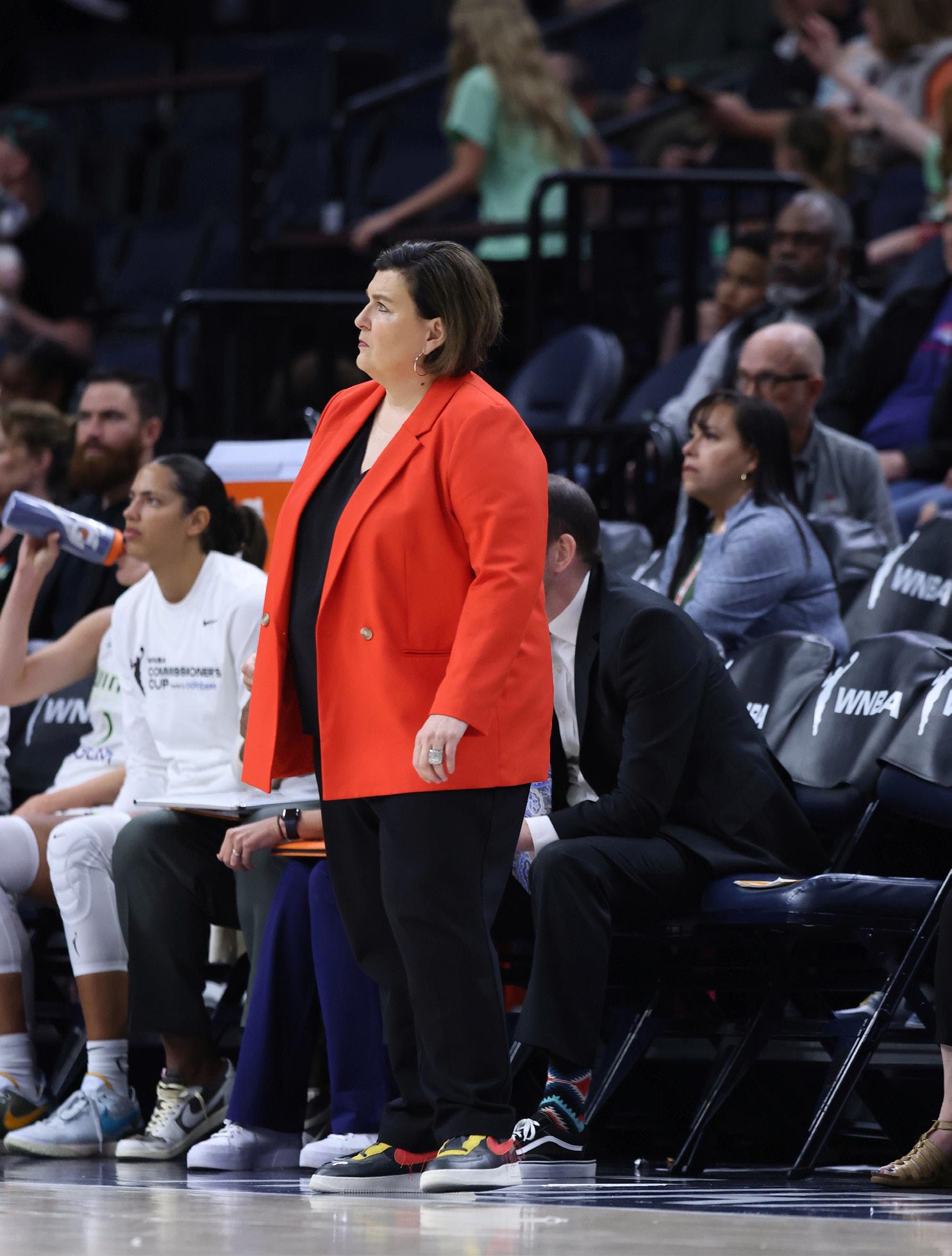
Our goal with Brewers Ballin’ is to feature Vassar athletes who starred for their team the week previous to publishing. If you would like to nominate an athlete, please email hfrance@vassar.edu.
Brewers Ballin’: North excels and impresses, capturing awards Brewers Ballin’
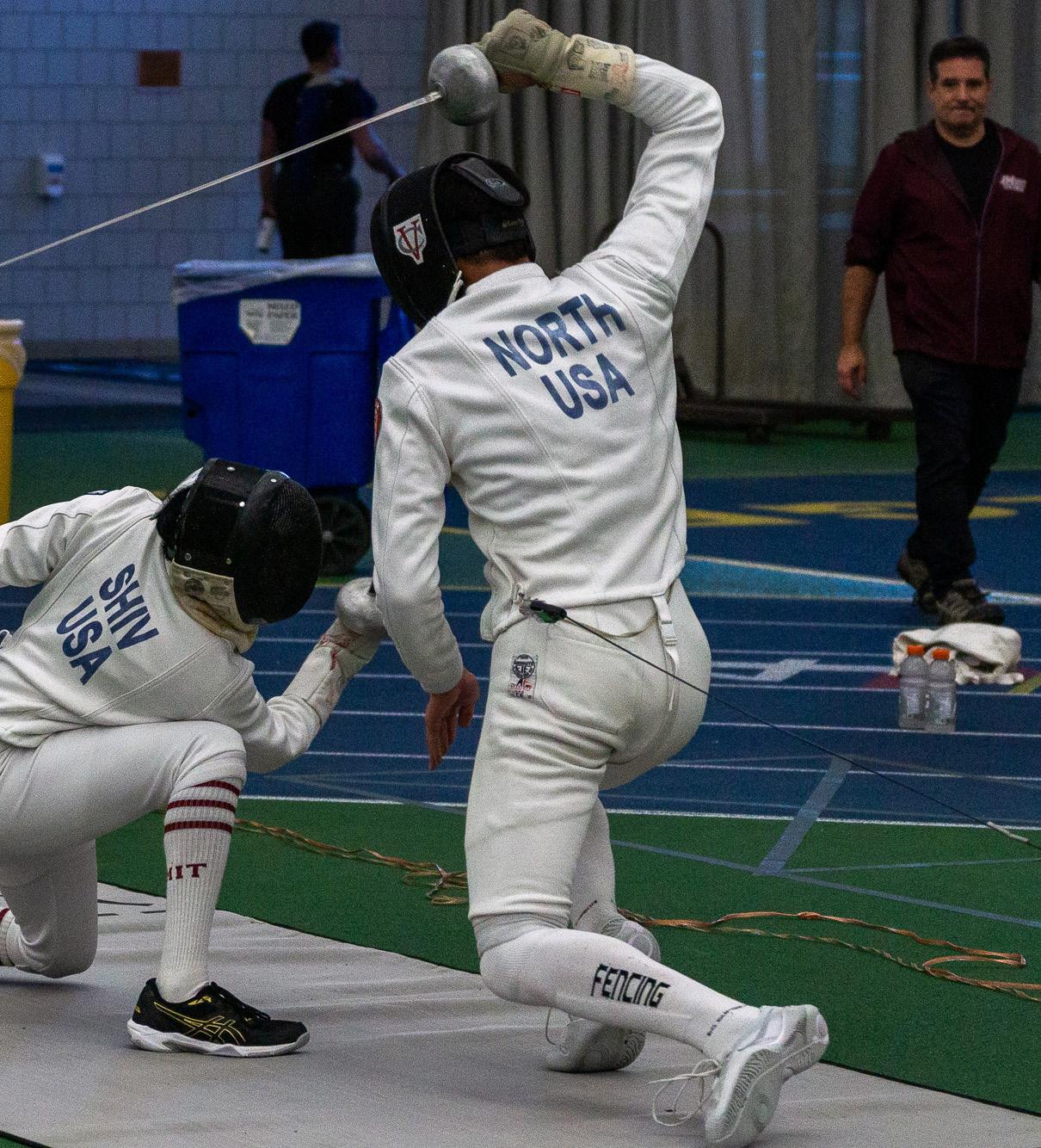
Name: Alexander North
Year: First-year
Team: Men’s Fencing
Stats: Last weekend was the cherry on top for an already stellar rookie campaign for North, as he dominated the Northeast Fencing Conference meet at Brown University over the weekend. Earlier in the season at the Vassar Invitational on Sunday Nov. 10., North led the Vassar Epee squad to a 45-18 record on the day. North went undefeated against Stevens, LIU, and Lafayette. On Saturday Nov. 2., North went 6-0 in pool play of the Big One on the campus of Smith College, before falling in the finals. North’s 16-2 record this weekend secured him the NFC Fencer of the Year and NFC rookie of the Year titles. North’s Fencer of the Year award was the first for the Brewers since Eli Polston ’18 won it in 2016.
Statement: “Fencing at its core is an individual sport, it’s about you versus your opponent, but having a supportive team behind you makes all the difference in your performance. When you have people cheering you on and relying on you to win, it brings out the best of your abilities and it’s what has pushed me the most this year.”
Recently in Vassar Brewers sports
Women’s XC compete at National Championship
On Nov. 23, the Brewers posted a program-best 20th overall finish at the 2024 DIII NCAA Championship race. Haley Schoenegge ’27 placed second in the race.
Men’s and Women’s Soccer Earn All-Region Selections
Between the squads, the Brewers earned eight all-region selections after stellar seasons. Jared Fiske '26 and Arden Tobolks '28 earned first team honors, Alice Crowley '28 a second team honor.
Men’s Basketball Top Mt. St. Mary
The Brewers added to their winning season with 104-54 domination. The win was a true team victory as 11 players recorded a field with five players in double digits.
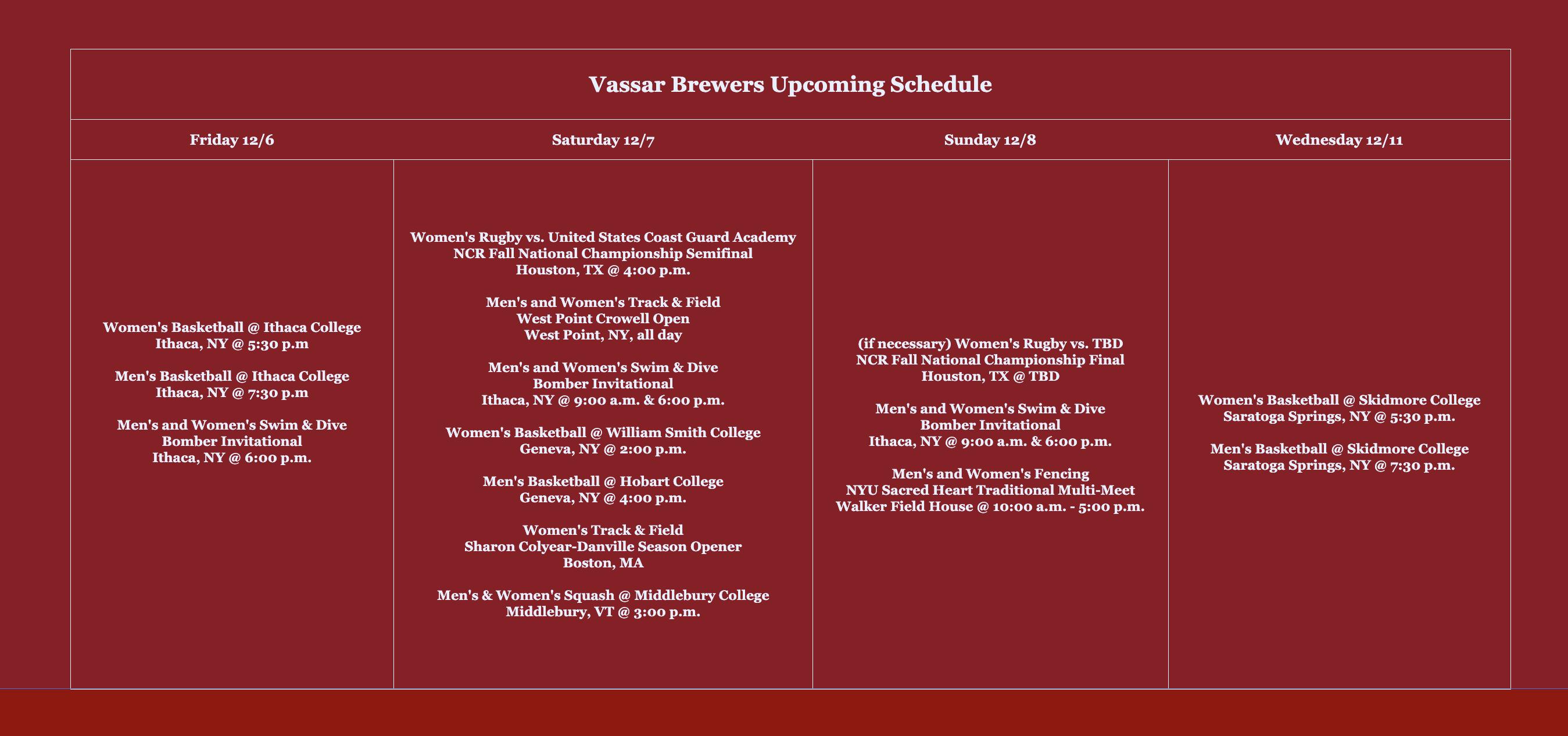
The Miscellany Crossword
“Blast from the
Past”
By Olivia Blank

Across
1. With 62-across, what history is said to do? Or a hint to the first halves of the starred clues
7. Expansive properties
14. Washington capital 16. Vessel for a frozen lake 17. Postmortem examination
18. Flipped out 19. *Academic institutions with ample spirit
21. This is not ___ (warning label)
22. Gambling inits.
23. ___-tac-toe
26. Gymnast’s perfect score
27. *Party dance that invites guests to “get funky”
32. Bracefaced “Finding Nemo” villain
33. Triangular intersection sign
34. Mark atop, as graph points
37. Not to be missed, as a TV show
39. Jackets named for a British school
40. ___ Vader
41. *Band with the 1998 #1 hit “Iris”
44. “Living at your grandparents’ place? Being in the ___ ? No Yale? Why did you drop out of Yale?”
47. Range of sizes, briefly
48. Spanish letters that may pose a challenge to new speakers
49. “Kim’s Convenience” actor Liu
50. *Ship affirmative
56. Comedian Chelsea
58. Home to “The Most Magical Place on Earth”
59. Street in Manhattan’s Alphabet City
60. Hear about
61. Like many tropical resorts
62. See 1-across
Answers to last week’s crossword: “Cheers” by Felix-Mundy Mancino
Down
1. Find hilarious
2. Solution created by dissolving
3. Slithering Florida invader 4. Atlanta university
5. Beloved sky bison from “Avatar: The Last Airbender” 6. NY AG James
7. “___ Grade,” 2018 Bo Burnham film
8. Discontinued iRobot vacuum
9. “A diller, a dollar, a ___ ‘clock scholar”
10. Cain’s victim
11. America is to paninis as Britain is to___
12. “The Raven” poet’s monogram
13. ___-Foy, Quebec 15. Shakespearean cries 20. ___-Cola
24. Not working
25. Surrender, as territory
27. Playground retort
28. Gender-affirming Rx
29. Trendy yoga brand
30. Networks: abbr.
31. Neighbor of Russ. and Pol.
32. Bell sound
34. Griffin and March
35. Small matter?
36. “No running” zone
37. Lead-in to practice or ware
38. WWW destination
40. Prescription amount
42. Stumped
43. Frozen CO2, familiarly
44. Longest serving female
senator Feinstein
45. Photo developing compound
46. Warnock vs. Walker election, e.g.
49. They’re just like us
51. Longings, slangily
52. Place for pins and needles
53. Maj.’s superior
54. “Whose woods these ___
think I know”: Frost
55. Developer’s map
56. Faux ___
57. December 24th or 31st



